Animals
Highly Intelligent and Possibly Invincible ‘Super Pigs’ Are Invading America

Something strange is stirring in America’s northern plains. Farmers, wildlife experts, and even ecologists are sounding the alarm about an unexpected invader: super pigs. These aren’t your typical barnyard animals or garden-variety feral hogs. They’re smarter, tougher, and spreading faster than anyone anticipated.
Originating in Canada, these hybrid creatures are moving southward, leaving destruction in their wake. They’ve adapted to survive harsh winters, evade capture, and disrupt the delicate balance of ecosystems. What’s driving their unstoppable spread, and why are they so difficult to control? The answers could change how we approach invasive species—and protect the landscapes they’re tearing through.
The Rise of ‘Super Pigs’: From Farming Experiment to Ecological Crisis

What started as a practical solution in Canada’s farming industry has spiraled into an ecological nightmare. Back in the 1980s, farmers bred domestic pigs with Eurasian wild boars to create hardy hybrids capable of surviving harsh winters and increasing meat production. On paper, it seemed like a win-win—tougher animals and higher yields. But when the demand for wild boar meat plummeted, the story took a dark turn.
Left with few options, some farmers released these resilient hybrids into the wild. What followed was a perfect storm: animals designed to thrive in challenging conditions adapting, reproducing, and spreading across Canada’s provinces. These “super pigs” didn’t just survive—they thrived, thanks to their intelligence and ability to evade traditional control methods.
Now, they’re pushing toward the northern United States, creating new challenges for wildlife managers and farmers. The unintended consequences of this farming experiment highlight a harsh truth: innovations, no matter how promising, can spiral out of control when the balance of nature is disrupted.
Why Super Pigs Are Hard to Stop
Super pigs have turned out to be a nightmare for ecologists and farmers alike, defying expectations at every turn. Their ability to thrive in extreme cold has left experts baffled. “That they can survive in such a cold climate is one of the big surprises of this issue,” says Ryan Brook, leader of the University of Saskatchewan’s Canadian Wild Pig Research Project. While most animals would struggle in frigid conditions, these hybrids dig through snow for food and use their wits to outlast even the harshest winters. It’s not just resilience—it’s survival with style.
But their cold-weather grit is only part of the story. Super pigs are ecological bulldozers. They’ll eat just about anything, from crops to wildlife. “Wild hogs feed on anything,” Brook explains. “They gobble up tons and tons of goslings and ducklings in the spring. They can take down a whitetail deer, even an adult.” That voracious appetite puts native species like deer, elk, and waterfowl in serious danger, as they’re outcompeted or outright preyed upon. What started as a novelty—something hunters once celebrated—has become an ecological disaster. As Brook bluntly puts it, “The downsides outweigh any benefit wild hogs may have as a huntable species.”
Adding to the challenge is their adaptability. These animals aren’t just hardy—they’re smart. They’ve learned to evade hunters, avoid traps, and exploit any resource available. For wildlife managers, it’s a constant game of catch-up. Containing their spread and minimizing the damage will require urgent, large-scale collaboration, but with their growing numbers and unmatched resilience, it’s an uphill battle that shows no signs of easing.

Super Pigs and Their Devastating Impact on Ecosystems
It’s hard to overstate just how much damage super pigs are causing. These voracious animals don’t just snack on the occasional plant or small animal—they devour everything in sight. “Wild hogs feed on anything,” says Ryan Brook, leader of the Canadian Wild Pig Research Project. “They gobble up tons and tons of goslings and ducklings in the spring. They can take down a whitetail deer, even an adult.” Let that sink in for a moment. These pigs aren’t just nibbling at the edges of the ecosystem—they’re bulldozing through it, disrupting food chains and endangering species that are already struggling to survive.
But it’s not just what they eat; it’s how they behave. Super pigs are notorious for their rooting habits, digging up soil like nature’s wrecking balls. This isn’t just bad news for native plants—they’re literally tearing apart habitats. Imagine a field left looking like a plowed construction site, except there’s no rebuilding plan. The consequences? Accelerated erosion, invasive species taking over, and ecosystems struggling to stay intact. And let’s not forget the farmers who wake up to find their cornfields and soybean crops destroyed overnight—because yes, super pigs aren’t picky about where they cause chaos.
And then there’s the disease factor. These animals aren’t just carriers of destruction—they also spread illness. One of the biggest fears is African swine fever, a highly contagious disease that could devastate livestock and disrupt the meat industry. Even humans and wildlife are at risk. All of this adds up to a massive environmental and economic problem, one that can’t be ignored. It’s a reminder that when invasive species run wild, the damage spreads far and wide—and we all end up paying the price.
Combating the Super Pig Invasion
Dealing with super pigs isn’t as simple as grabbing a trap and hoping for the best. These animals are clever, resilient, and spread fast, so tackling the problem demands a mix of traditional methods, cutting-edge strategies, and community involvement. One of the most effective approaches so far has been large-scale trapping. Corral traps baited to attract entire groups of pigs—known as sounders—can significantly reduce populations when used correctly.
For a more surgical approach, wildlife managers are turning to the “Judas pig” technique. As Ryan Brook, head of the Canadian Wild Pig Research Project, explains, this method involves collaring a single pig and tracking it back to its companions. “The idea is that you go and find that collared animal, remove any pigs that are with it, and in an ideal world, let it go again—it will just continue to find more and more pigs.” It’s a clever tactic that capitalizes on the pigs’ natural social behavior.
In areas with open terrain, aerial hunting using helicopters offers a rapid way to target large groups of pigs across vast areas. But it’s not just up to the professionals. Public participation is a key piece of the puzzle. Campaigns like “Squeal on Pigs” encourage locals to report sightings, giving wildlife managers the intel they need to act quickly. Regulations have also been put in place to crack down on the release and transport of live pigs, with penalties aimed at deterring illegal activity.
Combating the super pig invasion requires all hands on deck. From innovative methods like Judas pigs to community-driven initiatives, the goal is clear: stop these invaders before their impact becomes irreversible. With coordinated action, there’s still hope to protect ecosystems, farms, and communities from further damage.
Minnesota’s Fight Against Feral Swine

Minnesota has positioned itself as a key player in the battle against feral swine, taking proactive steps to keep these invasive animals at bay. While the state has been officially declared free of feral swine since the USDA eradicated a small group in 2016, the threat is far from over. “No truly wild pigs have entered the state,” says Gary Nohrenberg, Minnesota’s director of Wildlife Services. Still, officials are maintaining a watchful eye, knowing how quickly populations can spiral out of control if even a few pigs slip through the cracks.
To stay ahead, Minnesota’s Department of Natural Resources is preparing a comprehensive report aimed at identifying weak points in its current management strategies. This will guide new preventive measures to ensure feral swine don’t establish a foothold. The U.S. Department of Agriculture (USDA) is also stepping up its game, deploying aircraft and drones to monitor activity along the northern border—a critical line of defense against potential incursions.
Minnesota’s efforts are part of a larger, nationwide struggle. The USDA estimates there are now 6 million feral swine across 35 states, wreaking havoc on agriculture and ecosystems alike. While states like Vermont and Washington, with smaller populations, have made strides in eradication, heavily impacted areas like Texas face a tougher battle. “I think we’re making great strides toward success,” says Mike Marlow, assistant director of the National Feral Swine Management Program, “but eradication is not in the near future.”
Despite the challenges, Minnesota’s collaborative approach—paired with federal resources—offers hope. By combining vigilance, innovative surveillance, and strategic planning, the state is setting an example for how to prevent a small problem from becoming a national crisis.
A Growing Threat That Demands Urgent Action
The rise of super pigs in North America is a cautionary tale of unintended consequences. What began as an agricultural experiment has morphed into an ecological and economic crisis, with these resilient invaders leaving a path of destruction in their wake. From disrupting ecosystems and threatening native wildlife to destroying crops and spreading disease, the impact of super pigs is as varied as it is devastating.
The fight against this invasive species requires a united front. Innovative strategies like the Judas pig technique, aerial hunting, and large-scale trapping have shown promise, but these measures alone are not enough. States like Minnesota are leading by example, demonstrating how vigilance, strategic planning, and community involvement can slow the spread. Yet, as experts have noted, eradication remains a distant goal.
If there’s one lesson to take from the super pig crisis, it’s this: when nature is thrown out of balance, the consequences can ripple far and wide. Stopping super pigs will require sustained effort, bold innovation, and the commitment of everyone impacted—before the damage becomes irreversible.
Animals
Some Bees Live Just 30 Days. A Bee Pollinates About 150,000 And Makes Less Than A Teaspoon Of Honey. For You, It’s A Teaspoon Of Honey. But For A Bee, It’s Their Whole Life
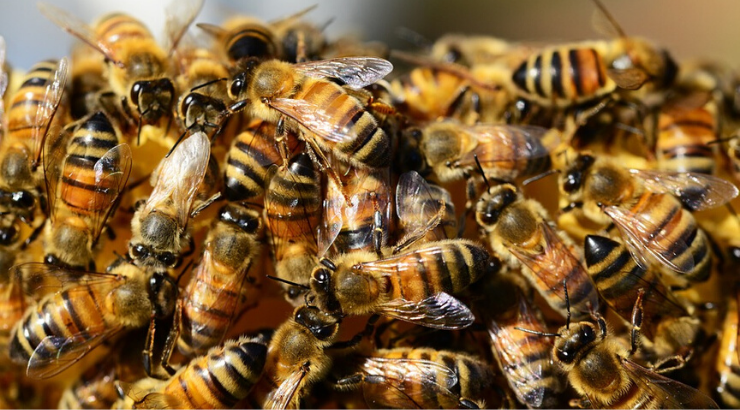
Honeybees are more than just buzzing insects; they are masterful architects of nature’s balance. Every flower they visit, every drop of nectar they collect, and every ounce of honey they produce is part of a grander purpose that sustains life as we know it. From their intricate social structure to their incredible work ethic, honeybees are nature’s unsung heroes.
But how much do we truly know about these fascinating creatures? What drives their tireless efforts, and why is their survival so critical to ours? As we savor the sweetness of their labor, it’s worth uncovering the hidden marvels of their world—one that is as fragile as it is extraordinary.
The Honey-Making Process
Honeybees transform floral nectar into honey through a remarkable process that combines foraging, enzymatic activity, and meticulous storage.
The journey begins with worker bees, aptly described as “nature’s vehicle for carrying out cross-pollination of the flowers” venturing out to collect nectar from various blossoms.
Using their proboscis, they extract the sugary liquid and store it in their honey stomachs, a specialized organ separate from their digestive stomach.
Upon returning to the hive, these foragers regurgitate the nectar, passing it mouth-to-mouth among house bees.
This repetitive process involves adding enzymes that break down complex sugars into simpler ones, effectively transforming the nectar’s chemical composition.
The partially processed nectar is then deposited into honeycomb cells.
To reduce its water content and prevent fermentation, bees fan their wings to promote evaporation, thickening the nectar into honey.
Once the honey reaches the desired consistency, the cells are sealed with beeswax, preserving the honey for future consumption.
This intricate method not only produces honey but also ensures the hive’s sustenance during scarce periods.
As noted by the British Beekeepers Association, “Honey bees are special in that they overwinter as a colony, unlike wasps and bumblebees,” highlighting the importance of honey as a year-round food source for the colony

A Lifetime of Labor
The life of a worker honeybee is a testament to relentless dedication and industriousness. Despite their brief lifespan of approximately six weeks during peak seasons, these bees achieve remarkable feats in honey production. A single worker bee produces about one-twelfth of a teaspoon of honey in its entire lifetime.
To put this into perspective, it takes the combined efforts of twelve bees to produce just one teaspoon of honey.
Scaling up, approximately 36 bees are required to make one tablespoon of honey over their lifespans.
Considering that a standard 16-ounce (about 454 grams) jar of honey contains 64 tablespoons, it would necessitate the lifetime work of over 2,300 bees to fill such a jar.
The process involves each bee visiting between 50 to 100 flowers per foraging trip, collecting nectar to bring back to the hive.
Collectively, to produce one pound of honey, bees must visit approximately 2 million flowers and fly over 55,000 miles.
The Beehive Community
A honeybee colony operates as a highly organized society, comprising three distinct castes: the queen, worker bees, and drones. Each caste fulfills specific roles essential for the colony’s survival and efficiency.
Queen Bee
The queen bee is the sole fertile female in the hive, primarily responsible for reproduction. She can lay up to 2,000 eggs per day during peak seasons, ensuring the colony’s growth and continuity. The queen also secretes pheromones that regulate the behavior and development of other bees, maintaining social harmony within the hive.
Worker Bees
Worker bees are sterile females that perform a multitude of tasks throughout their lifespan. Their duties evolve with age, starting as nurse bees caring for larvae, then progressing to roles such as cleaning the hive, producing wax, guarding the entrance, and eventually foraging for nectar and pollen. This division of labor is crucial for maintaining the hive’s functionality and productivity.
Drones
Drones are male bees whose primary role is to mate with a virgin queen from another colony. They are larger than worker bees and lack stingers, rendering them defenseless. Drones do not participate in foraging or hive maintenance. During mating flights, drones seek out queens, and successful mating results in the drone’s death. As resources become scarce towards the end of the season, drones are often expelled from the hive to conserve food for the winter months.
Bee Facts That Amaze
Honeybees are remarkable creatures, exhibiting behaviors and abilities that continue to astonish researchers and nature enthusiasts alike. Here are some fascinating facts that highlight their extraordinary nature:
- Impressive Flight Capabilities: Honeybees can fly at speeds ranging from 15 to 20 miles per hour, enabling them to efficiently forage over vast areas.
- Wing Beats: Their wings beat approximately 11,000 times per minute, producing the characteristic buzzing sound associated with bees.
- Sophisticated Communication: Honeybees perform a “waggle dance” to convey information about the direction and distance of food sources to their hive mates. This intricate dance involves moving in a figure-eight pattern and waggling their bodies, effectively communicating complex navigational details.
- Exceptional Sense of Smell: With 170 odorant receptors, honeybees possess a highly developed sense of smell, allowing them to detect specific floral scents and pheromones essential for hive communication.
- Vital Pollinators: Honeybees play a crucial role in pollinating approximately one-third of the food crops consumed by humans, making them indispensable to global agriculture.
- Efficient Foragers: A single honeybee can visit 50 to 100 flowers during each foraging trip, contributing significantly to the pollination process and the collection of nectar for honey production.
- Complex Social Structure: A typical honeybee colony can comprise up to 60,000 bees, each with specific roles such as foraging, nursing, guarding, and hive maintenance, demonstrating a highly organized social system.
- Unique Defense Mechanisms: Japanese honeybees have been observed using a behavior known as “wing-slapping” to defend their hives against invading ants. This involves rotating their bodies and flicking ants away with their wings, showcasing an evolved defensive strategy.
Bees and Their Ecosystem
Honeybees are indispensable to both natural ecosystems and human agriculture, serving as primary pollinators for a vast array of plant species. Their pollination activities facilitate the reproduction of approximately 85% of the world’s flowering plants, including numerous crops vital for human consumption.
In agricultural settings, honeybees significantly enhance crop yields and quality. They are responsible for pollinating a substantial portion of the global food supply, with estimates suggesting that about one-third of the food we consume relies on pollination by bees and other insects.
Beyond their role in food production, honeybees contribute to the maintenance of biodiversity. By pollinating a diverse range of plants, they support the habitats of various wildlife species, ensuring ecological balance. Their activities promote genetic diversity within plant populations, enhancing resilience to environmental changes.
The economic value of honeybee pollination is immense, contributing billions of dollars annually to global agriculture. In the United States alone, honeybee pollination is estimated to add over $15 billion each year to the agricultural economy.
However, honeybee populations face significant threats, including habitat loss, pesticide exposure, and diseases. The decline in bee numbers poses a serious risk to biodiversity and food security, underscoring the urgent need for conservation efforts to protect these vital pollinators.

Threats to Honeybees
Honeybees face a multitude of challenges that threaten their populations and, by extension, the ecosystems and agricultural systems that depend on them.
Pesticides
Exposure to pesticides, particularly neonicotinoids, has been linked to adverse effects on honeybee health, including impaired foraging behavior and increased mortality rates. Studies have shown that sub-lethal exposure to these chemicals can weaken bees’ immune systems, making them more susceptible to diseases.
Parasites and Diseases
Parasites such as the Varroa destructor mite pose significant threats to honeybee colonies. These mites attach to bees, weakening them by feeding on their bodily fluids and transmitting viruses. Infestations can lead to colony collapse if not managed effectively.
Habitat Loss
Urbanization and agricultural expansion have led to the loss of natural habitats for honeybees. The reduction in wildflower populations and nesting sites diminishes food availability and biodiversity, further stressing bee populations.
Climate Change
Climate change alters flowering times and the availability of forage plants, disrupting the synchrony between bees and their food sources. Extreme weather events can also destroy habitats and reduce the availability of nectar and pollen.
Invasive Species
The introduction of non-native species, such as the Asian hornet (Vespa velutina), poses a direct threat to honeybees. These predators can decimate bee colonies, leading to significant losses.
How to Help Honeybees
Honeybees play a crucial role in pollinating many of the crops that constitute our food supply. However, their populations are facing significant challenges. Here are several actionable steps you can take to support and protect these vital pollinators:
1. Plant Bee-Friendly Flora
Cultivate a variety of nectar and pollen-rich plants in your garden to provide essential food sources for honeybees. Opt for native species, as they are well-suited to local bee populations. Plants such as lavender, sunflowers, and heather are excellent choices.
2. Avoid Pesticides
Refrain from using pesticides, herbicides, and fungicides in your garden, as these chemicals can be harmful to bees. If pest control is necessary, consider organic or bee-friendly alternatives.
3. Create Bee Habitats
Provide shelter for bees by leaving sections of your garden undisturbed. Allow plant stems to remain through winter, and consider installing bee hotels to support solitary bee species.
4. Support Local Beekeepers
Purchase honey and other bee-related products from local, sustainable sources. This supports beekeepers who practice environmentally friendly methods and contributes to the health of local bee populations.
5. Educate and Advocate
Raise awareness about the importance of honeybees and the challenges they face. Engage with community initiatives aimed at bee conservation and advocate for policies that protect pollinator habitats.
6. Provide Water Sources
Place shallow dishes of water with pebbles in your garden to offer bees a safe place to drink. Ensure the water is clean and refreshed regularly to prevent stagnation.
7. Reduce Lawn Areas
Minimize expansive lawns in favor of diverse plantings that offer forage for bees. Allowing portions of your lawn to grow wild can create additional habitats for pollinators.
Sustaining the Legacy of Honeybees
Honeybees are the unsung heroes of our ecosystem, tirelessly working to pollinate plants, produce honey, and maintain biodiversity. Their intricate social structures, relentless dedication, and profound impact on agriculture highlight the vital role they play in our lives. However, as these extraordinary creatures face mounting challenges, it is our collective responsibility to ensure their survival.
By supporting honeybee-friendly practices, advocating for sustainable policies, and appreciating their contributions, we can protect these indispensable pollinators for future generations. The next time you enjoy the sweetness of honey or marvel at a vibrant garden in bloom, remember the incredible efforts of these tiny yet mighty workers. Together, we can safeguard the legacy of honeybees and the balance of nature they sustain.
Animals
X-Ray Reveals Rescue Dog Was ‘Shot in the Face’ Before Arriving at Shelter. Now, She’s Almost Ready for Adoption

Imagine walking through life with scars from battles no one could see—until one day, an X-ray reveals the truth. That’s the story of a brave rescue dog whose silent suffering came to light when shelter veterinarians uncovered a shocking secret: she had been shot in the face.
This discovery, hidden beneath her gentle demeanor, paints a picture of resilience few can fathom. How does a creature who endured such trauma still find it in her heart to trust again? Her journey from tragedy to recovery is a testament to the incredible strength of animals and the transformative power of compassion.

A Troubled Past Unveiled by an X-Ray
When this courageous rescue dog first arrived at the shelter, her past was a mystery. She walked into her new environment with a demeanor that hinted at pain but didn’t give away the gravity of what she had endured. Thin, wary, and subdued, she bore no visible signs of trauma, but there was a guardedness in her eyes that spoke volumes. It wasn’t until the shelter’s veterinarians performed a routine health check that the full weight of her story began to emerge. An X-ray revealed a horrifying discovery: fragments of metal were lodged in her skull, a stark reminder of the violence she had once faced. The images confirmed the unthinkable—she had been shot in the face.
The revelation left the shelter staff stunned and heartbroken. How could such a gentle, unassuming creature have survived such brutality? The gunshot wound, though inflicted long before her arrival, had never been treated, leaving behind not just physical scars but emotional wounds as well. Her ability to endure and adapt without any medical care was remarkable, but it also underscored the deep resilience animals often display in the face of unimaginable hardship. For the staff, it was a moment that reaffirmed their mission: they were not just rescuing a dog; they were rewriting her story, giving her a chance at the life she deserved.
Yet, despite all she had been through, there was a light in her eyes that refused to dim. It wasn’t the look of defeat or bitterness—it was survival, pure and simple. There was something profoundly inspiring about her quiet strength, the way she carried herself with a mix of caution and curiosity. Her story became a rallying cry for the shelter team, a reminder of why they do what they do. They knew they had been entrusted with a life that had been neglected and harmed, and they were determined to replace her pain with hope and healing.
From Trauma to Hope: The Shelter’s Role
The moment her story unfolded through that X-ray, the shelter’s team knew they had to act quickly. Beyond the physical injuries, there was a lifetime of emotional scars that needed addressing. The veterinarians set to work, carefully evaluating her condition to ensure she received the medical care she so desperately required. While her injuries no longer posed an immediate threat to her life, the remnants of that gunshot served as a constant reminder of her harrowing past. Pain management became a priority, as did monitoring her overall health, but the real journey was one of emotional healing.
The shelter staff, familiar with the fragility of animals who’ve suffered trauma, approached her with a mix of tenderness and patience. They understood that trust, once broken, takes time to rebuild. In the early days, her interactions were marked by hesitance. She flinched at sudden movements and kept her distance, as though bracing for harm. But with each passing day, a transformation began to take place. The consistent kindness of the staff started to chip away at her fear. Treats became a gateway to connection, and gentle words slowly coaxed her out of her shell.
Her journey to recovery wasn’t just about regaining physical strength; it was about learning to trust again. The shelter staff provided not only a safe haven but also an environment rich with love and reassurance. Volunteers spent hours sitting with her, reading quietly or simply being present, allowing her to acclimate to the idea that humans could be kind. Over time, she began to wag her tail tentatively and even approach her caretakers for affection. Her recovery became a testament to the profound resilience of animals and the power of compassion to heal even the deepest wounds.

A Glimpse into Her New Life
As the days turned into weeks, the dog began to reveal a personality hidden beneath the layers of trauma. Where there was once hesitance, there was now a growing sense of curiosity. Small gestures—like a tentative wag of her tail or the way she leaned in ever so slightly when a hand reached out to pet her—signaled the emergence of hope. Though her journey had been marked by pain, she was beginning to embrace the possibility of joy once more.
Shelter staff and volunteers often describe her as a quiet observer. She watches her surroundings intently, taking in the rhythm of daily life at the shelter. Despite her past, she shows signs of warmth and connection, especially with those who have been a constant presence in her life. Her interactions with people are growing braver; she no longer flinches at every movement. Instead, she has begun to greet familiar faces with soft nudges and a gentle wag. Her progress may be slow, but it is undeniable.
One particularly heartwarming moment occurred when a volunteer brought a plush toy into her kennel. At first, she regarded it with suspicion, sniffing cautiously. But eventually, curiosity won out, and she carried the toy to her bed—a simple, yet profound step in reclaiming the playfulness that had been stolen from her. Her recovery journey is not just about survival but about rediscovering the life she was meant to live. Every small milestone, from accepting a treat to curling up comfortably beside a volunteer, tells a story of a dog learning to trust and love again. Her resilience serves as a powerful reminder of the unyielding spirit animals possess and the difference that compassion can make in their lives.
The Dark Reality of Animal Cruelty
Her story is a stark reminder of the cruelty that countless animals endure every day. The fact that she survived a gunshot to the face and remained unnoticed, untreated, and unloved for so long highlights a much larger issue—animal abuse often goes unnoticed, hidden in the shadows where it thrives. Unfortunately, her experience is not an isolated incident. Reports from animal welfare organizations reveal alarming statistics: millions of animals are abused, abandoned, or neglected annually, with many cases never coming to light.
Her case also underscores the resilience of animals and the heartbreaking reality that so many suffer in silence. While her story has begun to take a hopeful turn, countless others are not as fortunate. Shelters across the country are inundated with animals bearing physical and emotional scars, much like hers. These organizations rely on limited resources to tackle the overwhelming task of providing care, rehabilitation, and safety to animals who have endured unimaginable cruelty.
This dog’s journey sheds light on the urgent need for greater awareness, education, and advocacy. Animal cruelty is preventable, but it requires community effort—individuals speaking up when they suspect abuse, supporting local shelters, and holding abusers accountable. Her survival is both a testament to her strength and a rallying cry to ensure no animal has to endure such suffering without help. Her story is a powerful reminder that while the scars of abuse run deep, compassion and action can change the lives of animals who desperately need a second chance.
Almost Ready for Adoption: The Journey Ahead
As the days pass, this resilient dog continues to blossom in the care of the shelter. Her physical healing has made tremendous progress, and her emotional recovery is gaining ground with each interaction. Her once-scarred face, though a constant reminder of her past, has become a symbol of her remarkable strength and endurance. She’s no longer the quiet, hesitant dog who arrived in fear; she is slowly becoming a confident, loving companion.
Her future now lies in the hands of potential adopters, but finding the right home is just as critical as her physical recovery. Shelter staff are carefully assessing her needs, looking for a family that can offer the patience, love, and understanding she requires. She has shown that she thrives in environments where she feels secure and where her emotional needs are met with gentleness. Her ideal home would be one where there are no expectations of instant perfection, but rather a willingness to allow her to settle in at her own pace.
Though the shelter is confident she will soon be ready for adoption, it is not rushing the process. They want to ensure that she finds the perfect family who will provide her with the stability and love she deserves. Whether that’s a quiet, calm home or one with another dog to be her companion, the focus is on ensuring that she is given the space to fully heal and thrive. Her journey isn’t over yet, but the finish line is in sight—and with the right adopter, she will soon experience the happiness she has waited so long for.
Animals
Hunter Killed After Shot Elephant Falls Over And Crushes Him

In the vast and untamed wilderness of Africa, the line between predator and prey can blur in unexpected ways. For one seasoned hunter, a routine expedition took a shocking and ironic turn when nature struck back with a force no one could have predicted. What began as a pursuit of big game ended in tragedy, leaving many to question the morality of hunting and the unpredictable power of the wild.
What happened that day serves as a stark reminder of the risks hunters face—and the lengths animals will go to defend their own. But the full story holds more than just drama; it raises deeper questions about humanity’s relationship with the natural world.
The Incident: When the Hunter Becomes the Hunted
In May 2017, Theunis Botha, a seasoned 51-year-old South African big game hunter, led a group near Zimbabwe’s Hwange National Park—a region previously spotlighted by the 2015 killing of Cecil the Lion. During this expedition, the hunters unexpectedly encountered a breeding herd of elephants, known for their protective and unpredictable nature.
As the group approached, three elephant cows charged directly at them. Botha responded by firing shots to deter the advancing animals. However, a fourth cow launched a surprise attack from the side, lifting Botha with her trunk. In an attempt to rescue him, a fellow hunter shot the elephant, resulting in her immediate collapse onto Botha, fatally crushing him.
Botha was renowned for pioneering European-style “Monteria hunts” in South Africa, utilizing packs of hounds to drive game towards hunters—a method traditionally reserved for smaller animals but adapted by Botha for larger predators like lions and leopards.
This tragic event underscores the inherent dangers of big game hunting, even for the most experienced individuals. It also highlights the unpredictable nature of wildlife, especially when animals perceive a threat to their young. Studies have shown that such encounters can lead to heightened stress responses in wildlife, potentially increasing the likelihood of aggressive defensive behaviors.
Nature’s Retaliation: A Rare Reality

Image credits: Twitter @JimKirstin51355
The tragic demise of Theunis Botha, crushed by an elephant during a hunt, underscores the unpredictable and perilous dynamics between humans and wildlife. While such fatal encounters are uncommon, they highlight instances where animals, acting on instinct, turn the tables on their pursuers.
In a similar incident, Argentine hunter José Monzalvez was trampled to death by an elephant during a hunting expedition in Namibia. As Monzalvez prepared to shoot, the elephant charged, leading to his untimely death.
These events illustrate the inherent risks of big game hunting, where the hunter can swiftly become the hunted. Elephants, known for their intelligence and strong social bonds, exhibit protective behaviors, especially when their young are threatened. Their size and strength make any defensive action potentially lethal.
Beyond elephants, other wildlife has also retaliated against human threats. For instance, in Alaska, a hunter was attacked by a brown bear, leading to a life-threatening situation. Such encounters emphasize the unpredictability of wildlife and the potential dangers faced by those who venture into their habitats.
The Controversy of Big Game Hunting
The tragic death of Theunis Botha has reignited debates surrounding big game hunting, a practice that elicits strong opinions on both ethical and conservation fronts.
Ethical Considerations
Critics argue that trophy hunting is morally indefensible, viewing it as the killing of animals for sport rather than necessity. Organizations like PETA contend that such practices inflict unnecessary suffering on wildlife, with the pleasure derived by hunters failing to justify the harm caused. The League Against Cruel Sports echoes this sentiment, asserting that even when targeting non-endangered species, the act remains unjustifiable. They also challenge the purported economic benefits, labeling them as insufficient grounds for perpetuating inhumane activities.
Conservation Implications
Proponents of trophy hunting often claim it contributes to conservation efforts by generating revenue for wildlife preservation and local communities. However, studies challenge this narrative. Research published in One Earth indicates that the impact of recreational hunting on biodiversity and livelihoods is complex, with findings suggesting that a single characterization of its impact on conservation is necessarily simplistic.
Furthermore, evidence suggests that trophy hunting can adversely affect animal populations. Targeting the most robust individuals for trophies may lead to genetic and social disruptions within species. For instance, removing dominant males can destabilize social structures and impede reproductive success, potentially accelerating population declines.
Economic Perspectives
The economic justification for trophy hunting is also under scrutiny. Reports indicate that the financial contributions from such activities to local economies are minimal. A 2017 study by Economists at Large found that trophy hunting accounted for less than one percent of tourism revenue in eight African countries. Additionally, concerns about government corruption suggest that funds generated may not effectively support conservation initiatives.
Public Sentiment
Public reaction to Botha’s death has been polarized. While some express condolences to his family, others view the incident as a manifestation of nature’s retribution against a practice they deem unethical. This dichotomy reflects a broader societal debate over the legitimacy and consequences of big game hunting.
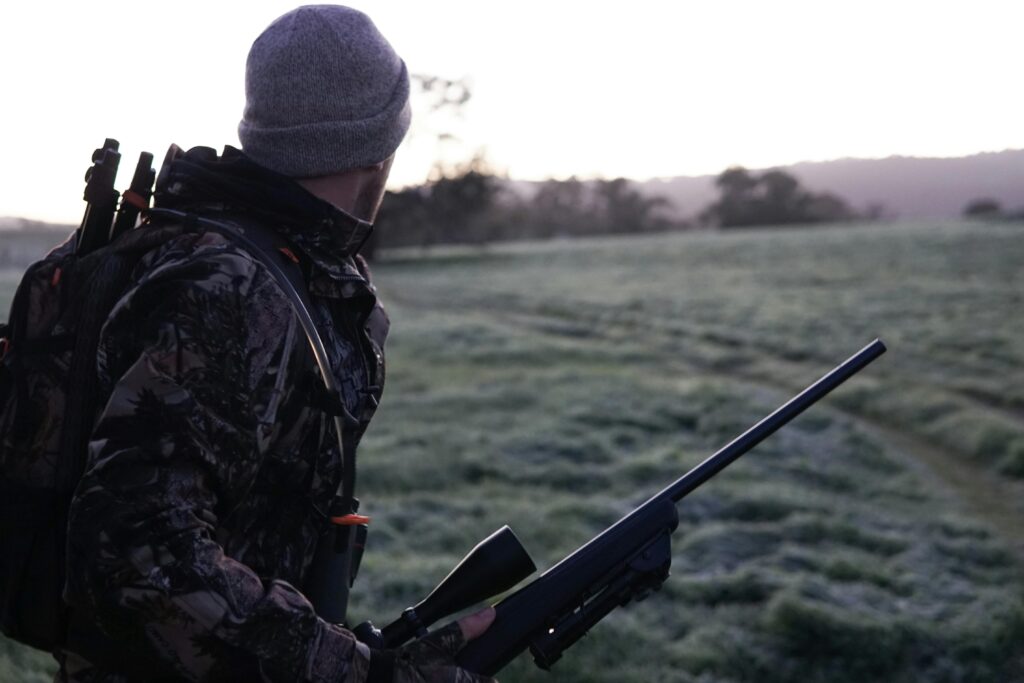
A Bigger Picture: The Consequences of Trophy Hunting
The tragic death of Theunis Botha has reignited discussions about the broader implications of trophy hunting on wildlife conservation, ethical considerations, and economic impacts.
Proponents of trophy hunting argue that it can contribute to conservation efforts by providing financial incentives to preserve wildlife habitats. For instance, in Namibia, regulated hunting has been associated with increases in certain wildlife populations, such as the mountain zebra, which grew from 1,000 in 1982 to 27,000 in 2014.
However, studies have shown that poorly managed trophy hunting can lead to negative ecological impacts, including altered age and sex structures within animal populations, social disruption, and even population declines. For example, selective hunting of male African lions has been linked to increased infanticide and social instability within prides.
While trophy hunting generates revenue, its economic significance is often overstated. A report by Economists at Large found that trophy hunting contributes less than 2% of overall tourism revenues in most African countries. Additionally, concerns have been raised about the equitable distribution of these funds, with limited benefits reaching local communities.
Ethical opposition to trophy hunting centers on the morality of killing animals for sport. Critics argue that it is unethical to take the life of a sentient being for recreation, regardless of any purported conservation benefits. This perspective is supported by animal welfare organizations that advocate for non-lethal conservation methods.
The debate over trophy hunting continues to evolve. In 2024, the UK proposed the Hunting Trophies (Import Prohibition) Bill, aiming to ban the import of hunting trophies. However, an Oxford-led study concluded that such a ban could cause more harm than good for the species it intends to protect, suggesting that a nuanced approach is necessary.
The Price of Trophy Hunting
The tragic death of Theunis Botha serves as a stark reminder of the unpredictability of nature and the consequences of human interference with wildlife. While some see the incident as a harsh act of nature’s justice, others view it as an unfortunate yet inevitable risk of big game hunting.
This story transcends one man’s fate; it reignites critical discussions about the ethical, ecological, and economic dimensions of trophy hunting. As wildlife populations face increasing pressures from habitat loss, poaching, and hunting, the need for more sustainable, non-lethal conservation methods grows stronger.
In a world where wildlife tourism generates far more revenue and preserves animals in their natural habitats, perhaps it’s time to reconsider humanity’s relationship with nature—not as a conqueror but as a guardian. For every action we take against wildlife, nature reminds us, in its own powerful way, that the balance is fragile, and the consequences are real.
Featured Image from Youtube @TheYoungTurks
Animals
Tragedy As Vet Takes His Own Life Using Drugs To Euthanise Pets
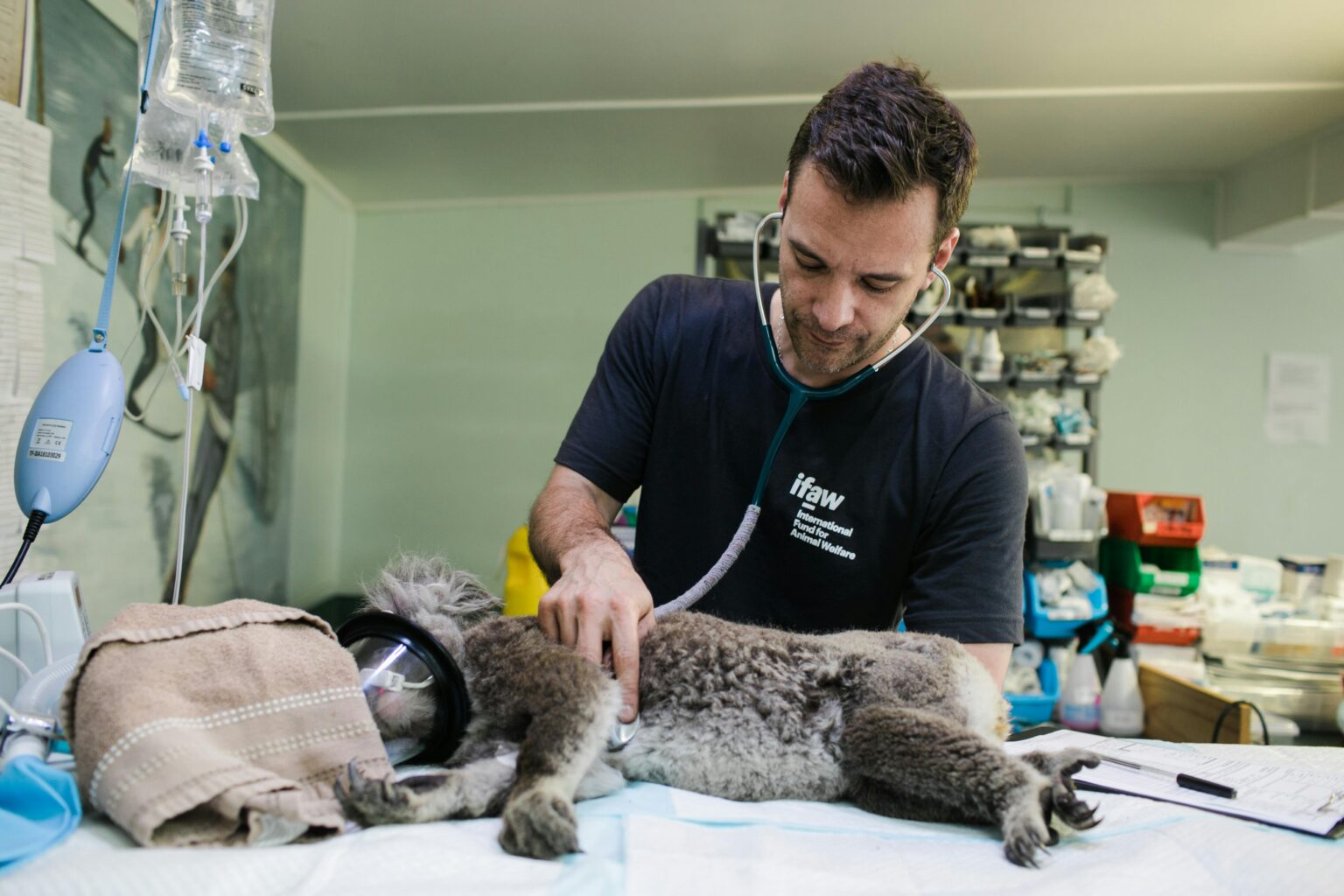
The veterinary profession, often seen as a calling for those who love animals, hides a darker reality that rarely makes headlines. Behind the compassion and dedication lies immense pressure, moral dilemmas, and emotional exhaustion that can weigh heavily on even the most talented professionals. In a tragic turn of events, a highly respected UK veterinarian’s life came to an abrupt end, leaving his family, colleagues, and community grappling with unanswered questions. What led to this devastating outcome? And how do the unique challenges of this field play a role in such heartbreaking incidents?
The Ethical Dilemmas of Veterinary Work
Veterinarians often navigate complex ethical landscapes, balancing the well-being of animals with the expectations and decisions of pet owners. This balancing act can lead to significant moral distress, especially when veterinarians are asked to perform actions that conflict with their professional and personal ethics.
A poignant example is the case of Dr. John Ellis, a UK veterinarian who tragically took his own life. Dr. Ellis was deeply troubled by situations where affluent clients, arriving in “brand new cars,” would request the euthanasia of their pets rather than opting for treatments. He expressed to his mother the frustration of dealing with such clients, contrasting them with less affluent owners who, despite financial constraints, would “do anything to save their animals,” often seeking help too late for effective intervention.
This ethical conflict is not isolated. A 2018 study found that 77% of veterinarians experienced moderate to severe stress due to ethical dilemmas, with 70% reporting minimal training in resolving these conflicts.
Common challenges include “economic euthanasia,” where financial limitations lead owners to opt for euthanasia over treatment, placing veterinarians in morally precarious positions.
The emotional toll of these dilemmas is profound. Veterinarians may experience “moral distress” when they are unable to act according to their ethical beliefs, leading to job dissatisfaction and psychological strain.
In Dr. Ellis’s case, the cumulative effect of these ethical challenges, compounded by personal struggles, culminated in a tragic outcome.
The Personal Struggles He Faced

Beyond the ethical challenges in his professional life, Dr. John Ellis grappled with significant personal struggles that compounded his distress. For the two years leading up to his death, Dr. Ellis was involved in an extramarital affair, unbeknownst to his partner of 12 years, Ashley James. This clandestine relationship added layers of guilt and emotional turmoil, contributing to what was described during the inquest as a “double life.”
The weight of maintaining secrecy, coupled with the fear of potential repercussions if his infidelity were discovered, likely exacerbated his mental health struggles. Such personal conflicts can intensify feelings of isolation and anxiety, particularly when combined with professional stressors.
In addition to relationship issues, Dr. Ellis faced financial pressures. He reportedly had trouble sleeping and would sometimes sleep in his car when on call, rather than go home and have to drive to the clinic in an emergency. His mother noted that all these factors “completely built up and he was finding it difficult.”
The intersection of personal and professional stressors can have a profound impact on mental health. A study published in the Irish Veterinary Journal highlights that veterinarians are at a higher risk of experiencing depression, anxiety, stress, and suicidal ideations compared to the general population.
The combination of ethical dilemmas at work and unresolved personal issues can create a cumulative burden, leading to severe psychological distress.
Systemic Issues in the Veterinary Industry

The tragic case of Dr. John Ellis underscores systemic challenges within the veterinary profession, particularly concerning mental health and access to euthanasia drugs.
Veterinarians face significant mental health challenges, with studies indicating elevated levels of anxiety, depression, and suicidal ideation compared to the general population. A report by Vetlife highlights that veterinarians experience higher levels of psychological distress, including anxiety and depressive symptoms.
The demanding nature of veterinary work, coupled with ethical dilemmas and client interactions, contributes to this mental health burden. A scoping review in the Irish Veterinary Journal emphasizes the prevalence of work-related stress among veterinarians, noting a high risk of suicide, burnout, and depression.
Dr. Ellis’s ability to obtain euthanasia drugs without adequate oversight highlights regulatory gaps. The Misuse of Drugs Regulations 2001 categorize controlled substances into schedules with varying levels of control. Schedule 3 drugs, often used for euthanasia, are subject to fewer controls, lacking mandatory safe custody requirements.
This regulatory framework can inadvertently allow easy access to potentially lethal substances. A recent coroner’s report expressed concern over the lack of adequate controls preventing misuse of euthanasia drugs by veterinary professionals.
Lessons and Calls for Action
The tragic loss of Dr. John Ellis serves as a poignant reminder of the multifaceted challenges faced by veterinary professionals. To prevent similar tragedies, it is imperative to address both the systemic issues within the industry and the personal struggles that individuals may face.
Enhancing Mental Health Support
Recognizing the high prevalence of mental health challenges among veterinarians, several initiatives have been established to provide support:
- Mind Matters Initiative (MMI): Launched by the Royal College of Veterinary Surgeons (RCVS), MMI aims to improve the mental health and well-being of veterinary teams through training, resources, and research.
- Vetlife Health Support: Offers confidential support to veterinary professionals dealing with mental health issues, providing access to mental health professionals who understand the unique challenges of the veterinary field.
- Not One More Vet (NOMV): A global initiative dedicated to providing support, resources, and education to veterinary professionals, aiming to reduce the stigma associated with mental health issues in the profession.
Implementing Stricter Controls on Euthanasia Drugs
The ease of access to euthanasia drugs, as highlighted in Dr. Ellis’s case, necessitates a review of current protocols:
- Regulatory Review: The Misuse of Drugs Regulations 2001 categorize controlled substances into schedules with varying levels of control. Schedule 3 drugs, often used for euthanasia, are subject to fewer controls, lacking mandatory safe custody requirements.
- Practice Protocols: Veterinary practices are encouraged to implement stricter internal controls, such as requiring dual authorization for the withdrawal of euthanasia drugs and maintaining detailed logs to monitor access.
Promoting Ethical Decision-Making and Communication
To alleviate the moral distress associated with ethical dilemmas in veterinary practice:
- Training Programs: Incorporate modules on ethical decision-making and client communication into veterinary education and continuing professional development to better prepare professionals for challenging situations.
- Support Networks: Establish peer support groups within practices to provide a platform for discussing ethical concerns and sharing experiences, fostering a culture of openness and mutual support.
Encouraging Work-Life Balance
Addressing the demanding nature of veterinary work is crucial:
- Flexible Scheduling: Implement work schedules that allow for adequate rest and personal time, reducing the risk of burnout.
- Resource Allocation: Ensure that veterinary teams are adequately staffed and resourced to manage workloads effectively, preventing excessive stress and fatigue.
Honoring a Life Through Reform
The story of Dr. John Ellis is a heartbreaking example of the toll that personal and professional pressures can take on even the most dedicated individuals. His tragic passing serves as a stark reminder of the challenges that veterinary professionals face daily—challenges that extend beyond the clinical setting into the deeply personal realm of ethics, mental health, and systemic flaws.
Moving forward, it is crucial to address the gaps that contributed to this loss. The veterinary profession must prioritize mental health support, implement stricter controls on potentially dangerous substances, and foster a culture that encourages open dialogue about the moral and emotional complexities of the field. Equally, as a society, we must show greater compassion for the people dedicating their lives to caring for animals, recognizing the emotional labor their work entails.
Dr. Ellis’s family and colleagues have expressed a desire for his death to inspire change. As they so poignantly stated, “No one should feel that they are alone.” By acting on the lessons from this tragedy, we can honor his memory and ensure that future veterinarians have the support they need to navigate the challenges of their vital work. Through systemic reform and collective compassion, we can build a better, more understanding future for those in this essential profession.
Animals
US Cruise Line To Launch Dog-Friendly Cruise In November 2025
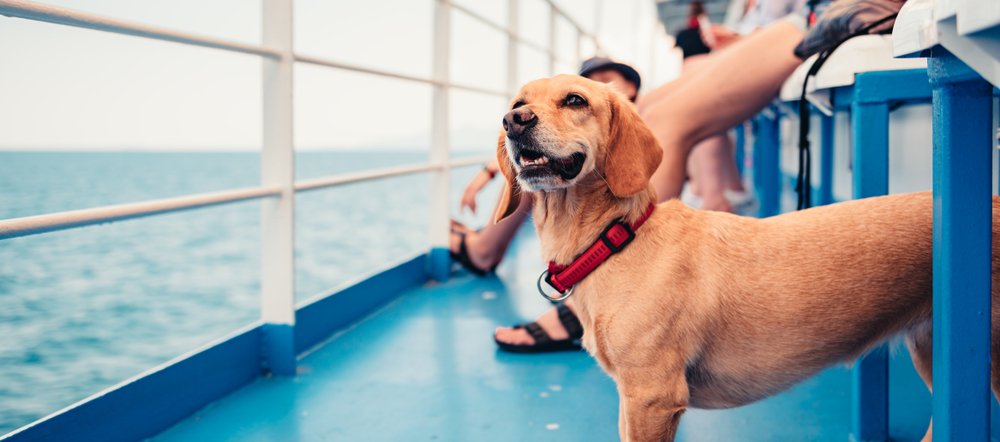
Imagine setting sail on a luxurious cruise where your four-legged best friend is not only welcome but celebrated. For years, pet owners have faced a tough choice when planning vacations: leave their beloved dogs behind or forgo the trip altogether. Now, that dilemma is about to change. A US cruise line has announced plans for a groundbreaking dog-friendly voyage in 2025, promising an experience unlike anything seen before on the high seas.
With exclusive amenities, exciting activities, and a few surprising rules, this innovative cruise aims to redefine travel for dog lovers. But what makes this sailing truly unique, and how exactly will it work?
The Vision Behind the Cruise
This initiative is driven by a deep-seated desire to integrate pets into the travel experiences of their owners, acknowledging the significant role that dogs play as family members.
Steve Matzke, the visionary behind Cruise Tails, encapsulated this sentiment, stating, “I consider my Yorkie, Louis, to be part of my family, and for years I missed out on the ‘family reunion’ cruise because I will not travel without him. I want to change that for myself and other dog lovers.”
This pioneering venture not only caters to the emotional bonds between pet owners and their dogs but also taps into a burgeoning market of travelers seeking pet-inclusive vacations.
By offering specialized amenities and activities tailored for canine companions, the cruise aims to set a new standard in the travel industry, where pets are not just allowed but celebrated as integral participants in the journey.
The overwhelming response to this announcement underscores the demand for such experiences, with thousands expressing interest in participating.
As Matzke noted, “The enthusiasm and positive response we’ve received so far have been incredible. We’re thrilled to be able to provide such a unique travel experience where dogs are not just allowed, but celebrated as part of the family.”

Onboard Amenities for Dogs
On the world’s first dog-friendly cruise, organized by Cruise Tails and Expedia Cruises of West Orlando, offers an array of amenities tailored to ensure a comfortable and enjoyable experience for canine passengers and their owners.
Each pet-friendly stateroom is equipped with a private relief station on the balcony, maintained by an assigned “Pet Butler” dedicated to the cleanliness and comfort of both the dog and its human companions.
To maintain a harmonious environment, dogs are required to stay in designated pet-friendly areas and are not permitted in specific zones such as restaurants, the casino, pool decks, and the spa.
This innovative approach to cruising reflects a growing trend among pet owners seeking inclusive vacation experiences.
A survey by the American Pet Products Association found that 37% of pet owners travel with their pets every year, a significant increase over past decades.
By offering specialized amenities and services, this cruise aims to set a new standard in pet-friendly travel, ensuring that both dogs and their owners can enjoy a memorable journey together.
The Cruise Experience
Embarking on this unprecedented voyage, both canine companions and their human counterparts can anticipate a plethora of engaging activities and amenities designed to ensure a memorable journey.
Pet-Centric Activities
- Costume Contests and Parades: Showcase your dog’s unique style in themed events that promise entertainment and camaraderie among guests.
- Dog Shows and Training Sessions: Participate in exhibitions and receive expert training advice to enhance your pet’s skills and behavior.
- Grooming Services and Puppy Massages: Pamper your pooch with professional grooming and relaxing massages, ensuring they feel as rejuvenated as you do.
- Splash Stations: Let your dog cool off and play in designated water areas tailored for safe canine enjoyment.
Human-Centric Amenities
While the cruise is tailored for dogs, human passengers are not left out. The ship boasts a variety of facilities, including:
- Dining Venues: Twelve chef-crafted, island-inspired dining options to satisfy diverse culinary preferences.
- Entertainment and Lounges: Thirteen action-packed lounges offering live entertainment and music for relaxation and enjoyment.
- Spa and Casino: Access to the St. Somewhere Spa & Salon for rejuvenation, and the Margaritaville Casino for those feeling lucky.
To maintain a harmonious environment onboard:
- Pet Butlers: Each family with a dog will be assigned a “Pet Butler” dedicated to maintaining cleanliness and attending to the pet’s needs throughout the voyage.
- Private Relief Stations: Staterooms accommodating dogs will feature private relief areas on balconies, ensuring convenience for pet needs.
- Designated Pet Areas: While dogs are welcome in many parts of the ship, certain areas such as restaurants, the casino, pool decks, and the spa are off-limits to maintain hygiene and comfort for all guests.
Steve Matzke of Cruise Tails shared his personal motivation behind the initiative: “I consider my Yorkie, Louis, to be part of my family, and for years I missed out on the ‘family reunion’ cruise because I will not travel without him. I want to change that for myself and other dog lovers.”

How to Join the Cruise
The world’s first dog-friendly cruise requires careful preparation to ensure a seamless experience for both you and your canine companion.
Application Process
Applications are now open for this exclusive voyage, with only 250 spots available for dogs. Interested pet owners should promptly submit their applications through the official Cruise Tails website.
Health and Vaccination Requirements
To ensure the well-being of all passengers, canine participants must be fully vaccinated and accompanied by a health certificate signed by a licensed veterinarian. This protocol is essential for maintaining a healthy environment onboard.
Pet Butler Service
Each dog-owning family will be assigned a “Pet Butler” to maintain cleanliness and comfort during the trip, ensuring a pleasant experience for all guests.
Designated Pet Areas
While dogs are welcome in many areas of the ship, certain zones such as restaurants, the casino, pool decks, and the spa are off-limits to maintain hygiene and comfort for all guests.
Booking Information
Reservations for the cruise began in December 2024. Given the limited availability and high demand, interested parties are encouraged to secure their spots promptly.
Challenges and Concerns
While the upcoming dog-friendly cruise by Margaritaville at Sea has generated significant excitement among pet owners, it has also sparked a range of concerns and criticisms from various quarters.
- Hygiene and Allergies: A primary concern revolves around maintaining cleanliness on board. With up to 250 dogs, ensuring sanitary conditions in shared spaces poses a considerable challenge. Potential issues include pet hair, odors, and the possibility of accidents in public areas, which could affect passengers with allergies or sensitivities.
- Safety and Behavior: The dynamics of having numerous dogs in a confined environment raise questions about safety. Unfamiliar surroundings and the presence of other animals might lead to unpredictable behavior, including aggression or anxiety-induced reactions. Ensuring that all canine passengers are well-behaved and that owners can effectively manage their pets is crucial to prevent incidents.
- Limited Options for Non-Dog Lovers: Some travelers express concerns that the introduction of pet-friendly cruises may reduce the availability of dog-free vacation options. They fear that if such cruises become popular, it could lead to a decrease in choices for those who prefer or require pet-free environments due to allergies, phobias, or personal preferences.
- Logistical Challenges: Accommodating a large number of dogs necessitates significant logistical planning. This includes creating adequate potty areas, ensuring the availability of veterinary care, and managing the additional staff required to cater to canine needs. Skeptics question whether the cruise line can effectively address these complexities without compromising the overall experience for all passengers.
- Impact on Cruise Experience: Traditional cruisers worry that the presence of numerous dogs might alter the ambiance of the voyage, potentially making it less relaxing and more chaotic. Concerns include noise from barking, disruptions in common areas, and the overall shift from the luxury experience they anticipate.
In response to these concerns, the organizers have implemented measures such as assigning “Pet Butlers” to maintain cleanliness and designating specific pet-friendly areas to mitigate potential issues. However, the success of this pioneering venture will largely depend on the effective execution of these strategies and the cooperation of all participants.
Paws at Sea: A New Era in Travel
The dog-friendly cruise by Margaritaville at Sea is more than just a novelty—it’s a bold reimagining of travel for pet lovers. With tailored amenities, engaging activities, and innovative solutions for practical concerns, this voyage offers an unparalleled opportunity for pet owners to share an unforgettable experience with their four-legged companions. While logistical challenges remain, the overwhelming excitement from travelers and pet enthusiasts alike indicates this initiative has the potential to redefine cruising for a new, pet-inclusive era.
As the waitlist opens and final preparations unfold, one question lingers: could this be the beginning of a new wave of pet-friendly travel? If this first voyage succeeds, the dream of setting sail with your loyal companion may soon become an annual tradition.
Animals
The Death Of A Pet Should Be Taken More Seriously By Counselors
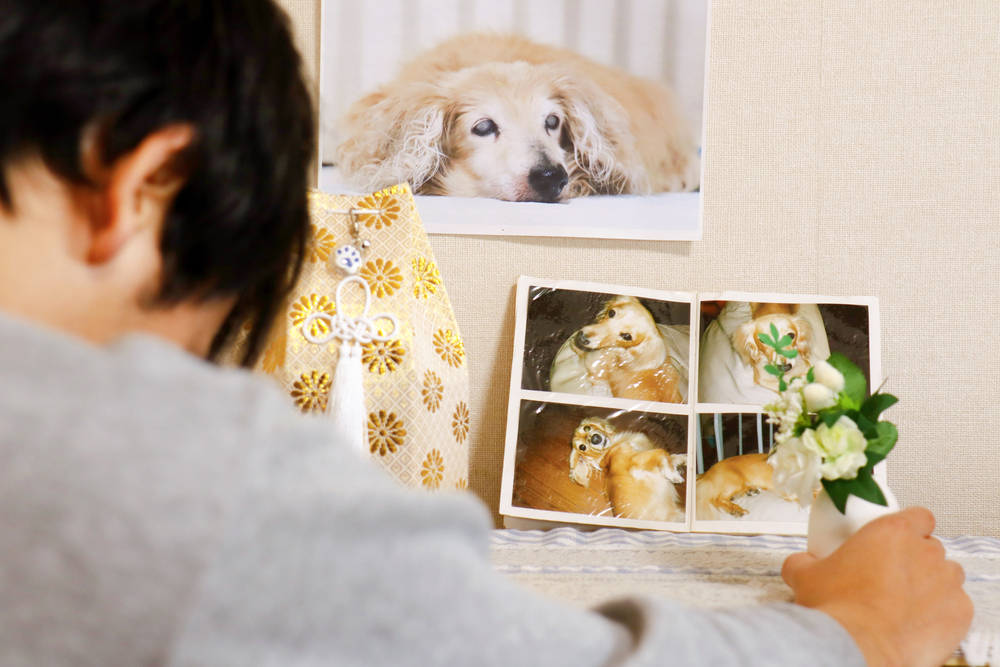
Pets hold a special place in our lives, often becoming as cherished as any family member. Yet, when we face the heartbreak of losing these beloved companions, the depth of our grief is frequently underestimated and misunderstood, not only by those around us but also by some professionals who guide us through our darkest times. Why is the death of a pet often not taken as seriously as the loss of a human?
The Psychological Impact of Pet Loss
The grief experienced after the loss of a pet is profound and often mirrors the emotional intensity associated with losing a human loved one. This grief is characterized by deep sadness, loneliness, and sometimes even depression. Researchers emphasize the importance of recognizing the strength of the human-animal bond, which can significantly impact an individual’s mental and emotional well-being. The bond with a pet is not merely emotional but also psychologically stabilizing, providing companionship, unconditional love, and a sense of purpose.
When a pet passes away, the owner may experience a range of intense emotions that can affect their psychological health. This type of grief, often referred to as disenfranchised grief, lacks societal recognition and validation, leaving individuals to cope with their loss in isolation. This lack of acknowledgment can complicate the grieving process, making it harder for pet owners to seek and receive support. Studies have shown that pet owners often turn to their pets for emotional support more frequently than to family or friends, highlighting the significant role pets play in their lives.
In therapy, recognizing the validity of grief associated with pet loss is crucial. Counselors and therapists are encouraged to treat pet bereavement with the same seriousness as the loss of a human. This approach not only validates the client’s feelings but also opens pathways for healing and recovery. Therapeutic interventions might include talking through the loss, creating memorials, or expressing feelings through art, which helps in acknowledging and processing the grief.
Moreover, societal attitudes towards pet loss are slowly evolving, with increasing recognition of the deep emotional bonds formed between humans and animals. This shift highlights the need for mental health professionals to develop strategies and interventions specifically tailored to help individuals cope with pet loss effectively.
Role of Counselors in Pet Bereavement

Counselors play a crucial role in supporting individuals through the grieving process of losing a pet, a role that requires sensitivity and recognition of the deep emotional impact involved. The grief experienced from pet loss can be as intense and profound as the loss of a human, which necessitates a specialized approach in counseling practice.
Counselors are tasked with understanding the unique bond between pets and their owners and recognizing that the loss can lead to significant emotional distress. It is essential for mental health professionals to validate these feelings rather than minimize them. Validation helps individuals feel understood and supported, which is a critical component in the healing process.
Effective counseling for pet bereavement might include creating a space where individuals can express their grief without judgment. This could involve discussing the pet’s role in their life, memories, and the feelings of emptiness that might follow the pet’s death. Therapists can use various interventions such as grief counseling techniques tailored specifically for pet loss, which may not be covered extensively in traditional grief counseling settings.
There is also a need for increased awareness and education among counselors regarding the significance of pet loss. Training programs and continuing education courses should include modules that focus on the psychological effects of losing a pet and strategies for providing effective support.
Incorporating the recognition of pet loss into therapeutic practices can significantly aid in normalizing these feelings and fostering a better coping environment. Counselors can guide clients in finding or forming support groups specifically for pet bereavement, which can provide additional communal support and decrease feelings of isolation.
Strategies for Counseling Pet Loss
Effective counseling strategies for pet loss involve recognizing the unique grief that comes with the death of a pet and providing support that acknowledges this significant emotional loss. Here are some tailored approaches that counselors can use to support grieving pet owners:
1. Validation of Grief
Counselors should begin by validating the client’s grief, affirming that their feelings of loss are both real and significant. Acknowledging the depth of the bond between the client and their pet helps to legitimize the grief process and can facilitate healing.
2. Educational Support
Providing educational materials that discuss pet loss and its impact can be incredibly helpful. Counselors can offer resources that explain the stages of grief specific to pet loss, which helps normalize the feelings that pet owners experience.
3. Therapeutic Techniques
Specific therapeutic techniques can be effective, including:
- Memory Boxes: Creating a physical box filled with mementos of the pet, such as collars, toys, and photos, can help clients process their grief by celebrating the life of their pet.
- Writing Letters: Encouraging clients to write letters to their deceased pets can facilitate expressing unresolved feelings and foster a sense of closure.
- Narrative Therapy: This involves helping clients tell their story of the pet’s life and death, which can aid in contextualizing the loss and its impact on their life.
4. Group Therapy
Group therapy sessions with other individuals who have experienced pet loss can provide a support network that helps diminish feelings of isolation. Sharing experiences with others who understand the unique nature of pet loss can be incredibly validating and healing.
5. Incorporate Rituals
Supporting clients in creating rituals to honor their pet’s memory can be therapeutic. Whether it’s a small ceremony, planting a tree, or creating an online memorial, these acts can help in the grieving process.
6. Support for Decision-Making
Counselors can also play a crucial role in helping pet owners make difficult decisions towards the end of a pet’s life, such as euthanasia. Providing a space to discuss these choices and the emotions surrounding them can be crucial.

Challenges in the Current Counseling Approach
The current approach to counseling for pet bereavement faces several challenges that can impede effective support for individuals experiencing the loss of a pet.
- Lack of Standardized Training: One significant challenge is the lack of standardized training and resources for counselors on how to handle pet loss effectively. While grief counseling is a well-established field, specific strategies and programs focusing on pet bereavement are not commonly included in standard counseling curricula. This gap can leave counselors unprepared to address the unique aspects of grief associated with pet loss.
- Societal Underrecognition: Another challenge is the societal underrecognition of pet loss as a legitimate form of grief. This societal stance can influence how professionals approach pet bereavement, potentially leading to minimized responses to such losses. When the grief over a pet is not seen as valid by society, it can create a barrier for those seeking help, as they may feel their emotions are not justified or understood.
- Psychological Complexities: The emotional complexities associated with pet loss also pose a challenge for counseling. Unlike human relationships, the bond with a pet is often devoid of the conflicts and complexities that characterize human interactions, which can make the grief feel more profound and unalloyed. Counselors need to navigate these deep emotional territories while acknowledging the purity and intensity of the bond, which might not be addressed in general grief counseling protocols.
- Need for Specialized Approaches: The counseling field needs more specialized approaches that recognize the significant emotional impact of pet loss and the necessity for targeted therapeutic interventions. Effective grief counseling for pet loss should include elements such as validation of the client’s feelings, exploration of the pet’s role in the client’s life, and assistance with developing new coping mechanisms.
A Call to Recognize Pet Loss in Counseling
As we navigate the complexities of human emotions, the loss of a pet presents a significant, yet often overlooked, challenge. Counselors play a crucial role in addressing this unique form of grief, fostering an environment where pet owners feel validated and supported. The death of a pet can trigger profound grief that is every bit as intense as the loss of a human loved one, yet societal recognition remains insufficient. This article underscores the importance of developing specialized training for counselors, enhancing therapeutic approaches, and promoting societal acknowledgment of pet bereavement.
Integrating tailored counseling strategies, such as validation of grief, educational support, and therapeutic techniques, can significantly aid in the healing process. Moreover, the formation of support groups and the encouragement of commemorative rituals can offer additional comfort and community support to those in mourning.
Recognizing pet loss as a serious bereavement issue not only legitimizes the deep emotional bonds formed between humans and their pets but also advances the field of mental health to encompass all forms of familial loss. It is time for counseling practices to evolve and adapt, ensuring that every individual receives the empathetic support they need during times of profound loss.
Animals
Three ‘Rhino Poachers’ Eaten By Lions After Breaking In To South African Game Reserve
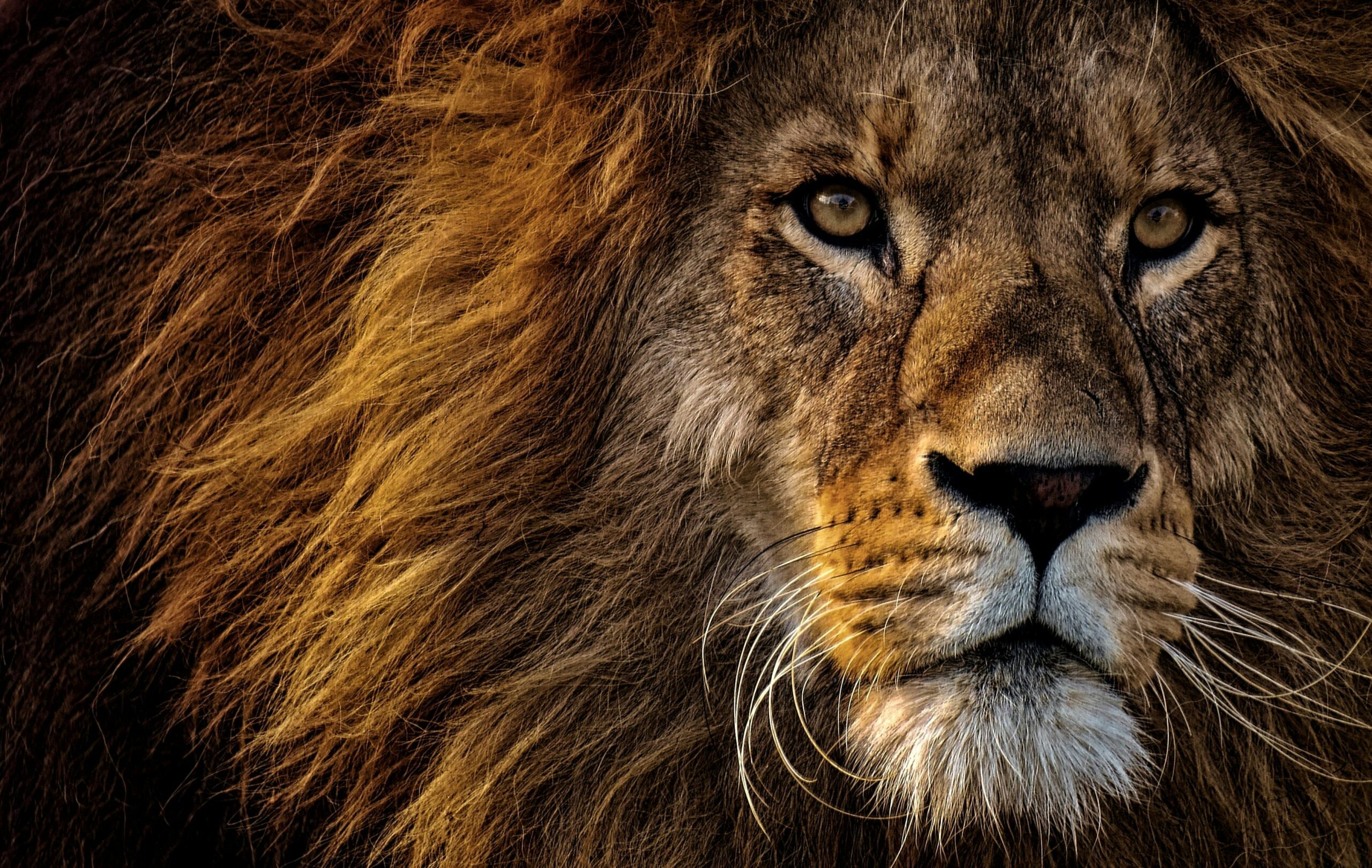
Africa’s rich wildlife has long been a symbol of the continent’s natural beauty, but this heritage faces a relentless threat from poaching. Iconic species like rhinos and elephants are being driven toward extinction, targeted for their horns, tusks, and other body parts that fuel an illegal, global trade. This crisis doesn’t just harm animals—it disrupts ecosystems and affects local communities that rely on balanced biodiversity for their livelihoods.
While conservationists work tirelessly to protect these species, the battle is far from over. Sometimes, though, nature reminds us of its own power. A striking example of this unfolded in South Africa’s Sibuya Game Reserve, where a group of poachers met an unexpected and deadly fate. This incident, both grim and symbolic, sheds light on the larger struggle to protect Africa’s endangered wildlife from exploitation.
The Sibuya Game Reserve Incident: When Poachers Became Prey
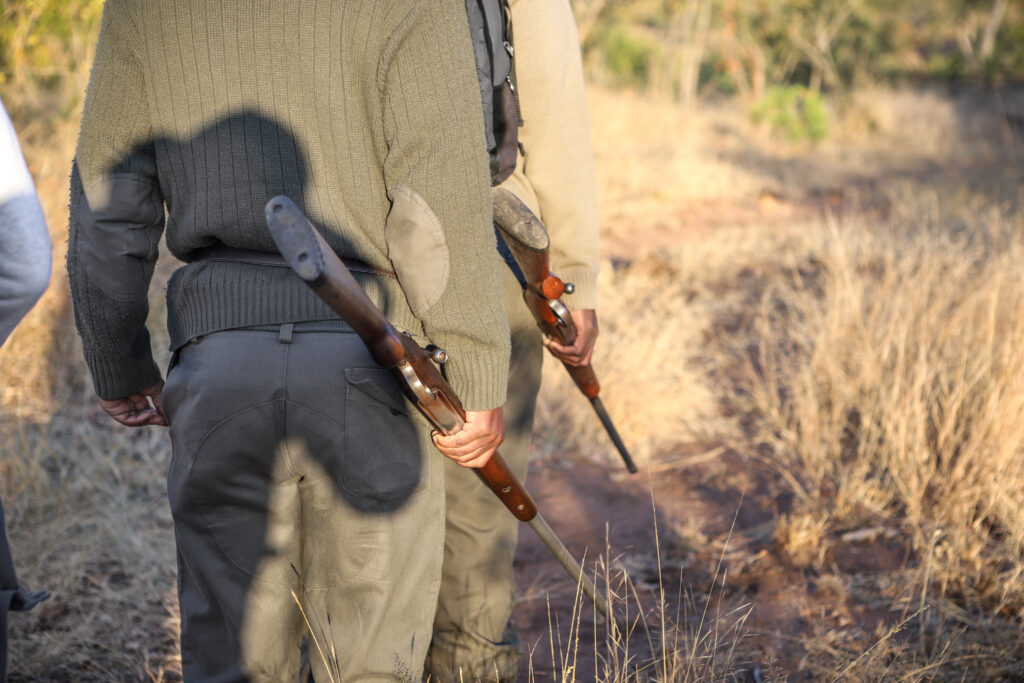
In 2018, South Africa’s Sibuya Game Reserve became the scene of an extraordinary and tragic event. A group of poachers, armed with tools to kill rhinos and harvest their horns, entered the reserve under the cover of night. Their mission, fueled by the lucrative black market trade in rhino horn, took a fateful turn when they crossed paths with a pride of lions.
The outcome was brutal and final. The poachers became prey themselves, leaving behind only scattered remains, tools, and torn shoes. For the rangers who discovered the grisly scene, it was a sobering reminder of the risks poachers take—and the raw power of the animals they exploit.
While some saw the incident as a form of poetic justice, it sparked deeper conversations about the dangers of poaching and its root causes. It also served as a grim reminder that nature, often seen as fragile in the face of human greed, has a resilience and unpredictability that should not be underestimated.
The Economics of Rhino Poaching
Rhino poaching isn’t just about killing animals—it’s part of a massive, illegal trade fueled by myths and money. In parts of Asia, rhino horns are falsely believed to have medicinal powers or represent wealth and success. Despite being made of keratin, the same material as human fingernails, they’re sold for jaw-dropping prices on the black market.
This high demand has turned poaching into big business, run by well-funded criminal networks. These syndicates exploit struggling communities, recruiting people to do the dangerous work of killing rhinos, while they smuggle the horns into global markets. The damage goes beyond the animals; entire ecosystems suffer, and local communities lose out on the balance they depend on for farming, tourism, and livelihoods.
What makes it worse? These syndicates have resources conservationists can only dream of. They bribe officials, use high-tech gear, and stay one step ahead of enforcement. It’s clear that saving rhinos isn’t just about protecting them on the ground. The demand for their horns needs to stop, and the criminal operations behind this cruel trade need to be dismantled.
Consequences for Wildlife and Ecosystems
Losing rhinos isn’t just sad—it’s a problem that ripples through entire ecosystems. Rhinos play a huge role in shaping their environments. They graze, stomp around, and help keep plants in check, which creates space for other animals to thrive. When they disappear, it’s not just about losing an iconic species—it’s about throwing nature off balance.
For example, black rhinos and white rhinos were once everywhere across Africa. Now, their numbers have dropped so much that the northern white rhino is functionally extinct, with only a few individuals left, protected 24/7 by armed guards. This isn’t just a blow to nature—it’s a hit to the local communities who depend on healthy ecosystems for farming, clean water, and wildlife tourism.
Without rhinos, habitats can change in ways that affect countless other species. The plants grow differently, other animals struggle to survive, and even local economies suffer because fewer tourists visit. Saving rhinos isn’t just about them—it’s about protecting everything connected to them, including the people who rely on nature to make a living.
Empowering Communities to Combat Poaching
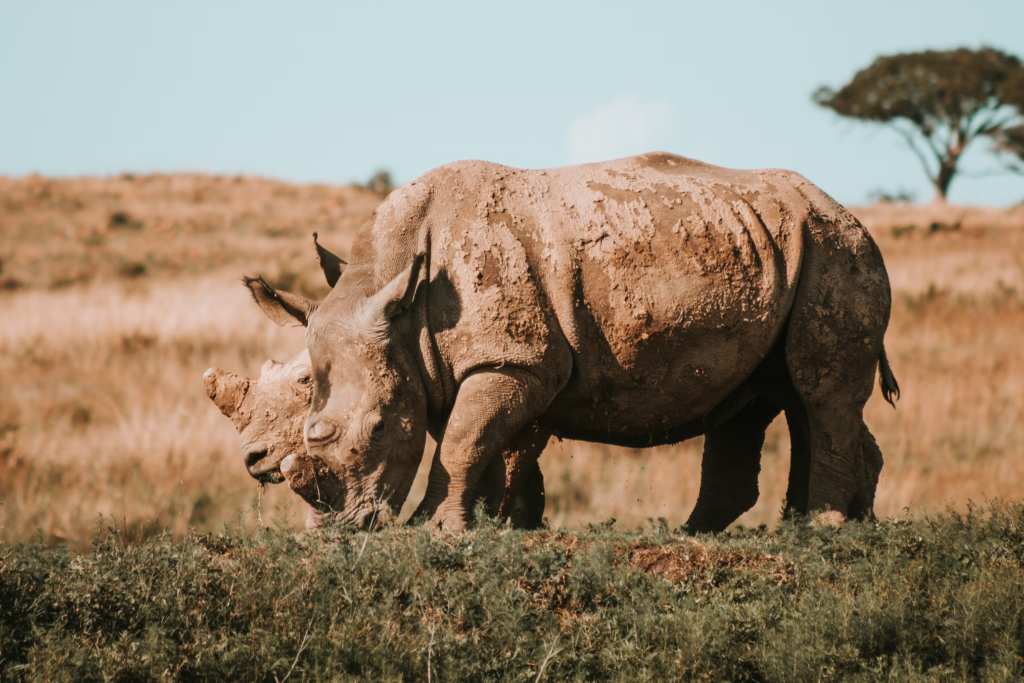
The people who live near wildlife reserves are often the first to notice when something’s wrong. They hear the gunshots, spot unfamiliar footprints, or see strangers moving through their land. But for many of these communities, life is tough. Jobs are scarce, and poaching can seem like a way to put food on the table—no matter how risky or illegal it is.
That’s why helping these communities is one of the best ways to fight poaching. Giving people jobs that protect wildlife, like working in eco-tourism or joining ranger teams, turns them into partners in conservation instead of participants in poaching. Programs that teach people how important animals like rhinos are for the land—and for future generations—can also make a big difference.
The challenge, though, is corruption. Poaching syndicates often bribe their way past laws and officials, making it harder to protect wildlife. But when communities feel like they have a stake in keeping rhinos alive, they’re far more likely to stand up to those trying to exploit them. Conservation isn’t just about saving animals—it’s about giving people hope and a reason to care.
A Sobering Reminder of Nature’s Balance

The Sibuya Game Reserve incident is more than just a story of poachers meeting an unexpected fate. It serves as a stark reminder of the delicate balance between humanity and nature—a balance that is too often disrupted by greed and exploitation. While the lions’ actions may seem like poetic justice, the root of the issue remains unresolved. Poaching is a symptom of deeper societal and economic problems, from poverty to cultural misconceptions about wildlife.
This event also underscores the power of nature to resist human interference. Despite humanity’s advances, ecosystems remain intricate and unpredictable, capable of responding in ways that remind us of our place in the natural order. The incident challenges us to reflect on our actions and their consequences, not only for the animals we endanger but also for ourselves as stewards of this planet.
Protecting endangered species like rhinos requires a global effort, one that combines education, enforcement, and community engagement. By addressing the underlying drivers of poaching and fostering a greater respect for nature, we can begin to restore balance and ensure the survival of these magnificent creatures for generations to come.
Protecting Rhinos: A Fight for Balance in Nature
The fight against poaching is about more than just saving rhinos—it’s about protecting the balance of nature and securing a future where people and wildlife can thrive together. The Sibuya Game Reserve incident is a stark reminder of the risks and consequences tied to exploiting the natural world. While the story might seem like nature’s way of evening the score, it also highlights the deeper issues we need to address.
Conservation isn’t just the responsibility of governments or big organizations—it’s something we all play a part in. Supporting initiatives that provide communities with better livelihoods, spreading awareness about the truth behind rhino horn myths, or even contributing to anti-poaching programs can make a difference. Every small effort adds up.
Rhinos, and the ecosystems they help sustain, need more than protection—they need a world that values their existence. By working together, we can turn the tide and ensure these incredible animals have a future. Nature has shown its strength; now it’s our turn to show compassion and responsibility.
Animals
Spray This Simple 2-Ingredient Mixture & You Will Never See Spiders, Fleas, Flies, Lice, Mice, Moths and More in Your Home
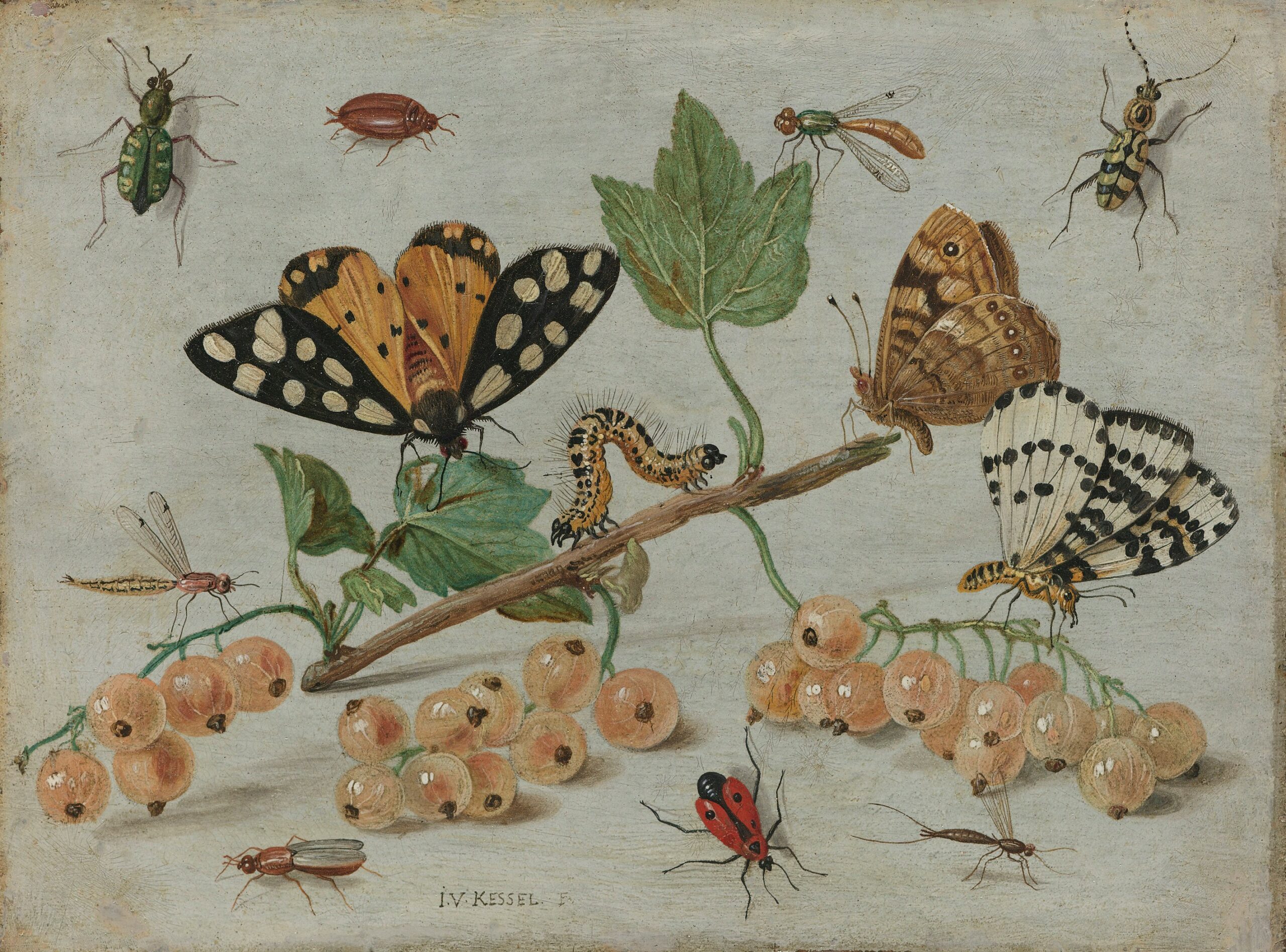
Picture this: you’re relaxing at home, enjoying a peaceful evening, when an unexpected guest scurries across the floor—a spider, perhaps, or an unwelcome ant. Most people’s instinct is to reach for the nearest can of chemical spray, but what if there was a simpler, safer, and all-natural solution lurking in your pantry?
Enter peppermint oil—nature’s secret weapon against a variety of common household pests. While you may associate its fresh scent with holidays or tea, this unassuming essential oil packs a surprising punch when it comes to keeping creepy crawlies at bay. But how exactly does it work, and why are so many people turning to peppermint as a natural alternative?
As you read on, you’ll discover the science behind peppermint oil’s pest-repelling properties, practical tips for using it in your home, and essential precautions to ensure it’s safe for everyone—including your pets. Ready to unlock the power of peppermint?
Why Peppermint Oil?

Peppermint oil has earned its reputation as an effective natural remedy for repelling pests, and there’s solid science to back this claim. While it may be a favorite in aromatherapy or teas, this essential oil contains powerful compounds that drive pests away. The key components, menthol and menthone, disrupt the sensory pathways of pests, making peppermint oil an excellent natural deterrent.
In a 2001 study conducted at Auburn University, researchers tested the effects of mint oil on two common species of cockroaches—American and German roaches. The results were remarkable: peppermint oil repelled 100% of the cockroaches over the 14-day trial. These findings demonstrated that peppermint oil not only repels roaches but can also kill them under prolonged exposure. Its toxicity to insects stems from these active compounds, which are present in high concentrations in peppermint oil.
Beyond cockroaches, peppermint oil works on a variety of other pests. Spiders, for example, are extremely sensitive to peppermint because they “taste” with their legs. The strong smell overwhelms their sensory receptors, forcing them to retreat. Similarly, peppermint oil can repel fleas, lice, ants, mice, and even moths. Research has also shown that when applied to the skin, peppermint oil can prevent mosquito bites for up to 150 minutes.
The advantage of peppermint oil lies in its ability to provide natural pest control without the risks associated with chemical pesticides. Unlike DEET, a common ingredient in store-bought repellents that has been linked to health issues in humans and animals, peppermint oil is non-toxic when used properly. It’s a win-win: you keep pests out of your home, and your environment stays chemical-free.
Practical Applications and DIY Peppermint Insect Repellent Recipes
Peppermint oil serves as a highly versatile and effective natural solution for pest control, providing an eco-friendly alternative to chemical-based repellents. Whether you’re dealing with spiders, ants, cockroaches, or mosquitoes, peppermint oil can be incorporated into various practical applications around your home. By making your own DIY repellent, you can control both the ingredients and the concentration, ensuring a safe environment for your family and pets.
Peppermint Oil Spray
The most common way to use peppermint oil is by creating a spray. This versatile method allows you to target areas where pests are most active, such as around windows, doorways, or countertops. To make the spray:
- Mix 10-15 drops of peppermint essential oil with one cup of water.
- Add a teaspoon of dish soap to help the oil mix more evenly with the water.
- Shake the bottle thoroughly before each use, and spray directly on surfaces where bugs are likely to enter.
The peppermint spray works well against spiders, ants, and cockroaches. For outdoor use, it can also be sprayed around patios and garden furniture to repel mosquitoes. Regular reapplication is essential as the scent will fade over time, particularly after rain or cleaning.
Peppermint-Soaked Cotton Balls
In areas where a spray might not reach effectively—like small spaces or hard-to-reach corners—using peppermint-soaked cotton balls can offer a more concentrated and long-lasting effect. Here’s how:
- Soak cotton balls in undiluted peppermint oil.
- Place them in areas such as cupboards, closets, and under sinks where pests commonly hide.
This method is especially useful for keeping ants, spiders, and cockroaches away. Refresh the cotton balls every few weeks to maintain potency.
Enhancing Your Repellent with Other Essential Oils
To increase the effectiveness of your homemade spray or cotton ball repellent, you can combine peppermint oil with other essential oils known for their pest-repellent properties. For instance, tea tree oil is excellent for repelling ants and cockroaches, while lavender oil works well against flies and mosquitoes. Adding a few drops of these oils to your peppermint-based spray can create a more comprehensive solution.
Safety Concerns and Pet Precautions

While peppermint oil is a fantastic natural solution for keeping pests at bay, it’s essential to exercise caution if you have pets, particularly cats and dogs. Peppermint oil can be toxic to pets, especially when used in high concentrations or ingested. For instance, dogs may experience symptoms such as vomiting, lethargy, or skin irritation if exposed to undiluted peppermint oil. Cats, even more sensitive, can suffer from severe reactions like tremors or respiratory issues.
To safely use peppermint oil around pets, always dilute it significantly—use 10-15 drops of peppermint oil per cup of water—and avoid spraying it directly in areas where your pets frequently play, sleep, or eat. Make sure your pets have a way to avoid or exit rooms where you’ve diffused peppermint oil, and never leave a running diffuser unattended in a closed room. Additionally, if you suspect your pet has been exposed to peppermint oil and is showing signs of distress, contact your vet immediately.
When considering flea or tick prevention, it’s better to consult a veterinarian about safe alternatives to peppermint oil, which can sometimes be too potent for pets.
Comparison With Other Natural Remedies
When it comes to natural pest control, peppermint oil is often at the top of the list for its versatility and effectiveness against a range of pests, including spiders, ants, and mosquitoes. However, several other essential oils offer similar, and in some cases complementary, benefits. Understanding how peppermint compares to other natural remedies can help you make informed decisions about your pest control strategy.
- Tea Tree Oil: Tea tree oil, known for its strong antibacterial and antifungal properties, is also an effective insect repellent, particularly against ants, cockroaches, and dust mites. While peppermint oil is potent against spiders and mice, tea tree oil’s strength lies in its ability to target common indoor pests like ants and termites. However, tea tree oil can be more toxic to pets, especially cats and dogs, so extra caution is needed when using it around animals.
- Lavender Oil: Lavender oil is another natural insect repellent, often used to ward off flies, moths, and mosquitoes. Lavender has a calming scent, making it a good choice for indoor use where a more relaxing atmosphere is desired. While peppermint oil provides strong protection against more robust pests like cockroaches and spiders, lavender excels in repelling flying insects and can double as a room freshener.
- Eucalyptus Oil: Eucalyptus oil, particularly known for its effectiveness against mosquitoes, fleas, and dust mites, is a strong outdoor repellent. Its sharp aroma acts as a barrier that flying pests dislike, making it an excellent choice for outdoor seating areas. Eucalyptus is particularly good for creating a bug-free zone during summer months, but it can be less versatile indoors compared to peppermint oil, which works well in tight spaces like cabinets and baseboards.
- Citronella Oil Citronella oil is one of the most widely recognized natural remedies for repelling mosquitoes. Its citrusy scent masks human odors that attract mosquitoes, making it highly effective for outdoor use. Citronella is often used in candles or torches for backyard pest control, whereas peppermint oil is more effective in enclosed areas where direct application is needed.
Each of these oils has unique strengths, and combining them can provide a comprehensive natural pest control strategy. For instance, blending peppermint, eucalyptus, and citronella oils can target a wider range of pests both indoors and outdoors. This way, you can harness the specific strengths of each oil to create an eco-friendly, non-toxic solution for pest management.
The Natural Approach to Pest Control

Choosing peppermint oil and other natural remedies for pest control not only protects your home but also ensures the safety of your family, pets, and the environment. As we’ve seen, peppermint oil is highly effective against a range of pests, from ants and spiders to mosquitoes, offering a simple, eco-friendly alternative to chemical-based repellents. Moreover, combining it with other essential oils such as tea tree, lavender, or citronella can amplify its effectiveness, giving you a holistic approach to pest management. By using these methods, you’re not only safeguarding your living spaces but also embracing sustainable solutions.
Whether you opt for a DIY peppermint spray or rely on the potent power of essential oil blends, your home can remain a safe and pest-free haven, without the risks of harmful toxins.
Animals
As toxic wildfire smoke chokes West Coast, bird populations have gone missing
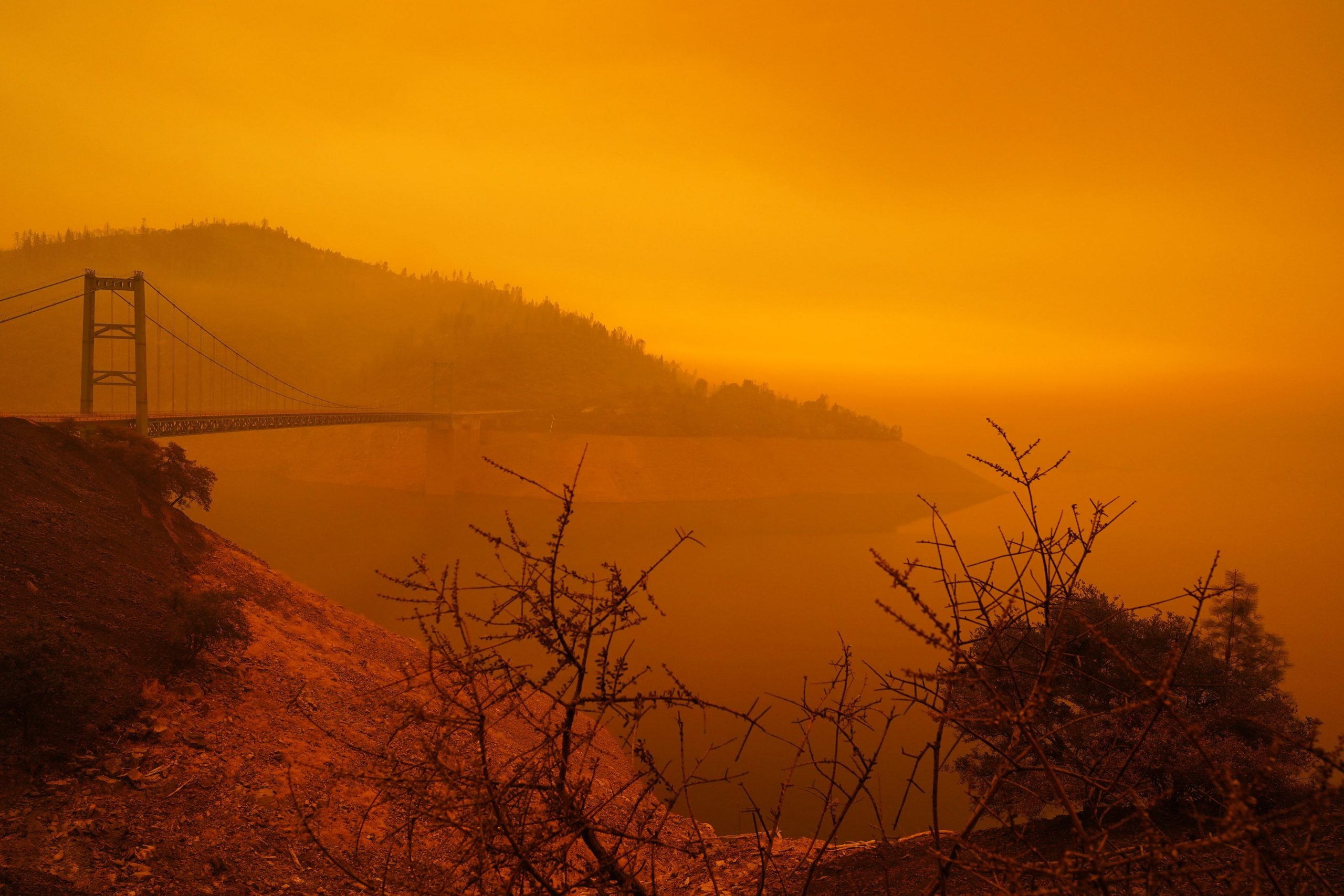
As the West Coast faces an unprecedented wave of fires across multiple states, bird lovers in California are realizing that many birds are simply disappearing or worse, turning up dead.
In the Birding California group on Facebook, bird watchers discussed the total silence that has come to their backyards, where the sounds of birds chirping and singing used to greet them in the morning.
“I live in Folsom—have not seen a bird or heard a bird chirp this morning,” said Jodi Root.
“We live in northern Nevada and have noticed the same thing,” added Gardnerville resident Karen Holden.
“Same here in Napa,” said Tammy Saunders, who said that things had become “very quiet which just adds to the eeriness of the orange colored dark sky.”
Almost 100 seasoned birdwatchers gave similar responses to the survey, with most noting that they saw a marked decline in birds visiting their feeders and birdbaths, as well as a clear thinning-out of the variety of species.
Like the insects that many birds rely on for food, wild bird populations have been in a state of major decline over recent years. However, the record-shattering heatwave and smokey, toxic air conditions in California and other western states haven’t only impacted human populations. Tragically, the ash that is falling across West Coast cities isn’t only comprised of trees and brush, but also includes the incinerated remains of birds and other creatures caught in the wildfires.
And as Deborah Pertersen of Inside Climate News reports, birds – with their highly sensitive respiratory systems that are instantly responsive to changes in environmental conditions – are acting as the global equivalent to the canary in a coal mine, at a time when seemingly the entire planet is on fire.
While much still remains unknown about how smoke impacts bird populations, doctoral candidate Andrew Stillman of the University of Connecticut notes that birds perpetually live on the edge, and extreme changes can have dire consequences for bird species.
“One thing that is important to point out is we do know high levels of smoke exposure can be harmful to birds,” Stillman told Inside Climate News. And unlike humans, birds “cannot escape like humans by going indoors.”
Veterinarians and bird scientists have also found that smoke can leave a damaging impact on the lung tissue of captive birds, leaving them susceptible to deadly respiratory infections, notes the Audubon Society.
“We do know that exposure to particulate matter, which of course is of great concern for human health, can affect birds as well,” said Olivia Sanderfoot, a National Science Foundation Graduate Research Fellow at the University of Washington Seattle who studies the impact of air pollution on birds.
And while the still-raging fires haven’t given researchers much of a chance to survey the population of birds along the west coast, the anecdotal evidence stacking up is clearly showing that the health effects of the massive plumes of smoke coming from over 85 fires raging in western states is hitting bird populations hard.
“Overall, it seems like the anecdotes suggest that there is a decline in bird activity during smoke events,” said Olivia Sanderfoot, a researcher at the University of Washington.
In a 2017 paper, Sanderfoot and Tracey Holloway wrote that “Birds have long been recognized as sentinel species for environmental change.”
The literature review concluded that “Exposure to air pollution clearly causes respiratory distress in birds and increases their susceptibility to respiratory infection,” in addition to causing complications to bird reproduction.
However, the science of wildfire smoke’s impact on birds remains largely undeveloped.
“We know pretty much nothing about the long-term impact of smoke on birds,” Sanderfoot said.
Indeed, most of the research on birds only covers a handful of species, and most of it focuses on air pollution rather than wildfire smoke.
“Of the roughly 10 000 species of birds known worldwide, only a few have been studied to characterize avian responses to air pollution, and the animals used in laboratory experiments may not be representative of the wild bird species most at risk from air pollution,” Sanderfoot and Holloway wrote.
Sanderfoot and her fellow researchers are now conducting studies in Washington, a state which saw some of the most hazardous air pollution ever recorded over the past week. Sanderfoot and her team are planting microphones and cameras in smokey areas to register whether bird songs decrease in high-smoke areas.
Tara Sears Lee, a nursery volunteer in Los Alto, California, has also observed the terrible impact of smoke on birds in recent days.
“Outside for 6 hours yesterday and no jays, crows, ravens, quail, turkeys, or hawks – all usual and very vocal visitors,” she wrote on Facebook. “Only hummingbirds, juncos, towhees and titmice. Worst of all was a dead hummingbird just lying on the ground – had heard they are being overcome by heat and smoke and just drop dead.”
Birders across the state are also posting photos on their Facebook accounts of dead hummingbirds in their backyards or, inversely, boosted numbers of birds at their backyard feeders – a result of the forced migration caused by fires.
“I think all the birds came to my house south of San Jose. Sometimes there will be more than 40-50 out there,” wrote Charlotte Trethway Noriega on Facebook.
As Petersen explains in her article, bird populations in North America have plummeted by 29 percent – or three billion birds – since 1970. And according to a 2019 study, rampant high temperatures resulting from climate change are likely to drastically alter the migration patterns of bird species. With pastures and grasslands being converted to crops, nesting places have dwindled along with the mass die-offs of insects eliminated by pesticides.
However, Stillman is finding some small traces of hope in his research of birds that have thrived in areas hit by wildfires. Black-backed woodpeckers are quickly returning to burned-out areas to feed on the larvae of wood-boring beetles that thrive on dying trees burned in fires.
However, Stillman notes “a very big caveat”: the new generation of “mega fires” like the one the West Coast is currently undergoing is far more destructive than those of the past, and the question of “how are the birds responding to this new normal” remains open.
Animals
To Study Hummingbirds Up Close, This Man Attached Feeders To His Glasses
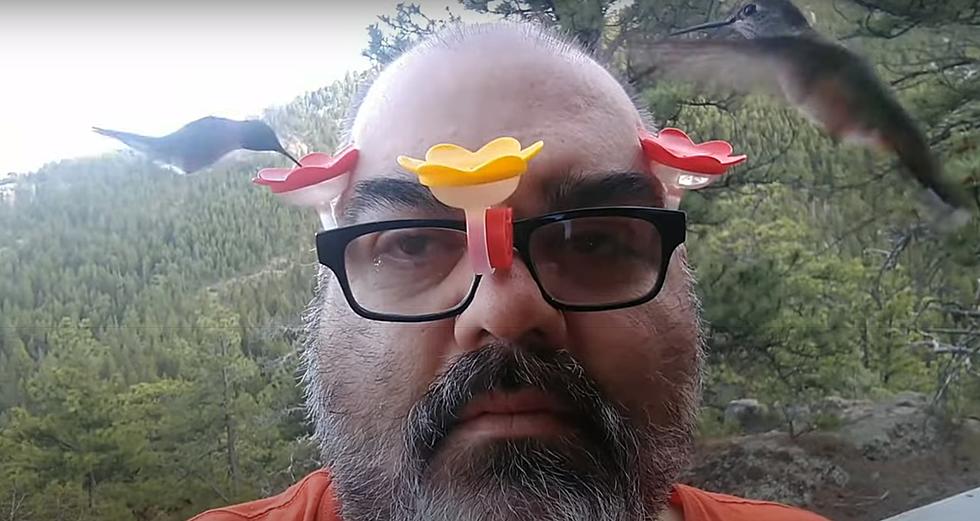
(TMU) – Late spring is the time when bird enthusiasts, and hummingbird lovers in particular, prepare to welcome these amazing little feathered creatures by polishing their special, brightly colored hummingbird feeders.
They are considered one of the smallest, beautiful and remarkable birds found in nature. Native to the Americas, most of the species measure between 2.95-5.11 inches (7.5–13cm) in length – the bee hummingbird, weighing just 0.07 ounce (2.0g) and 1.98 inches (5cm) in length being the smallest existing bird species.
Hummingbirds flap their wings so fast they create the humming sound they are named for and are the only birds that can fly backwards. Although found in Canada and across North America, they migrate to warmer climates to avoid the cold winters, they are found all year in much of the Caribbean and South America and in some of the warmer southern and coastal regions in the US and Mexico.
The North and South America is home to around 330 species of hummingbirds and while these birds have no sense of smell, they do have excellent color vision.
The Ruby-throated Hummingbird for instance, prefer tubular orange or red flowers. To attract them, simply plant red and orange flowers in the garden and/or use feeders with include those colors.
Hummingbirds drink the nectar by moving their forked tongue, which is as long as its beak, in and out of the flower or feeder about 13 times per second and can consume up to double their body weight in a day. And with all the energy used by those fast beating and humming wings, they don’t have to worry about gaining weight either.
Hummingbird enthusiasts sometimes get very creative to attract these birds to their gardens by providing the sweet nectar and intricate, colorful feeders. Quite a few get very creative with their feeder designs, especially when wanting to experience the birds up close and very personal.
A man from Lyons, Colorado for example, attached plastic feeders to his spectacles for a real up-close hummingbird experience.
His design was successful as the birds didn’t seem to mind being so close to a human and happily sipped the sugar water on offer while their rapidly flapping wings hummed around his face.
Spencer Staley, a ‘bird nut’, turned himself into hummingbird feeder a couple of years ago.
Staley converted a safety helmet by adding seven feeders, attached at the tips of thin metal rods. With his innovative human feeding station Staley was able to feed hundreds of birds in a short period of time.
A Costa Rican enthusiast also created a similar hat feeder, albeit on a smaller scale, with three feeders attached to a hat with wire, providing him with a very close view of the birds sipping the nectar.

Flickr
When there’s nectar to be had, hummingbirds don’t seem to mind getting close to humans, even close enough to be fed by hand, but be prepared to be patient should you want to give this method a try.
Animals
Watch the Magical Moment a Pod of Dolphins Glide Through Electric Blue Bioluminescent Waves

(TMU) — Spectacular video footage has been captured showing dolphins literally glowing in neon blue as they swim off the coast of Southern California.
The brilliant scene was captured on Wednesday just as night fell on Newport Beach in Orange County.
The footage was taken by photographer Patrick Coyne of the website Orange County Outdoors, who recently garnered international headlines after taking photos of crashing blue bioluminescent waves in the same coastal waters last week.
Orange County Register reports that Coyne and his fried Ryan Lawler, the owner of Newport Coastal Adventure, were out at sea in an inflatable boat hoping to capture video of creatures illuminated by the bioluminescent water, a natural phenomenon that has allowed Coyne and his colleagues to garner worldwide attention and once-in-a-lifetime shots every photographer dreams of.
The two were just about to call it quits when they suddenly noticed two dolphins near them, who appeared out of the pitch black ocean to swim alongside their small boat. The contrast of the deep, dark ocean water against their illuminated, slender bodies was something they couldn’t believe—and it lasted for about 15 minutes.
Lawler explained:
“They were bow riding, they were super into the boat. About five minutes in, two more came and we had a little pod of four dolphins … It was amazing.”
Coyne was simply blown away by the moment. He said:
“I was like, this can’t be happening.
“This is so magical. After the two dolphins were playing with us, a few more joined in.”
Glowing Dolphins After Sunset!
The biolumenesnce off Newport Beach has been out of this world! Last night Capt. Ryan took the Zodiac out to look for dolphins, and together with friend Patrick Coyne filmed this amazing interaction with a pod of dolphins as they lit up the night.
Posted by Newport Coastal Adventure on Thursday, April 23, 2020
The rare spectacle of glowing blue water caused by algal blooms has been present off some beaches along the Pacific Coast in the past week, most notably in Newport Beach and Acapulco.
The natural phenomenon is known as bioluminescence, and is caused by an increase in the dinoflagellate population. The dinoflagellates—which are tiny, swimming plants—include Lingulodinium polyedra, which is responsible for the glowing waves. Dinoflagellates contain enzymes and proteins that create small light flashes.
During the day, the algal bloom appears as a deep red, rusty tide due to the heavy concentration of small photosynthetic organisms floating up to the surface. When the sun goes down, however, movements such as crashing waves—or in this case, swimming dolphins—make the tiny organisms display light.
Describing the bioluminescence he witnessed last week, Coyne said:
“As soon as the set crashes, it’s a burst of blue light. It’s not always the perfect burst of blue light, you want it to be dark.
“Once it hits, it’s a burst of blue light and you get that color. And it really does look like what you see in pictures and videos.”
Coyne had been dreaming of capturing such night-time footage of dolphins ever since he saw the Netflix film, “Night on Earth,” which used moonlight-sensitive, high-tech low-light cameras and heat-tracking technology to capture nocturnal scenes of marine life.
“It’s not something you can just plan. It was showing up in little sections, we would drive the boat a bit, it would be bright and then it would go away.
“You can’t really find it, it’s pitch black. We could see it when it would start glowing, there’s no way for us to predict it.”
Coyne admits that the moment was so “magical” that he couldn’t help but shed a tear.
“Hands down the most incredible experience of my life.
“I’ve been really lucky, this truly tops everything.”
“We’re pretty proud of [the dolphin footage.]
“I don’t know how many people will ever see that in their life. I didn’t think I’d ever see this in my life, to be honest. It was truly one of the most magical nights of my life.”
-

 Awareness1 week ago
Awareness1 week agoMarathon Runner Diagnosed With Terminal Cancer Urges People Not to Dismiss Small Symptom He Experienced
-

 News2 weeks ago
News2 weeks ago9 Eerie Stories Of Third Man Syndrome, When People Claimed An Unseen Presence Helped Them Survive A Disaster
-
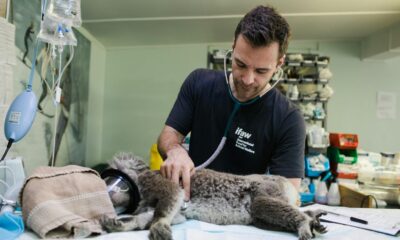
 Animals1 week ago
Animals1 week agoTragedy As Vet Takes His Own Life Using Drugs To Euthanise Pets
-

 Awareness1 week ago
Awareness1 week agoDoctors Warn Cooking Oil Used By Millions May Be Fueling Explosion Of Colon Cancers In Young People






